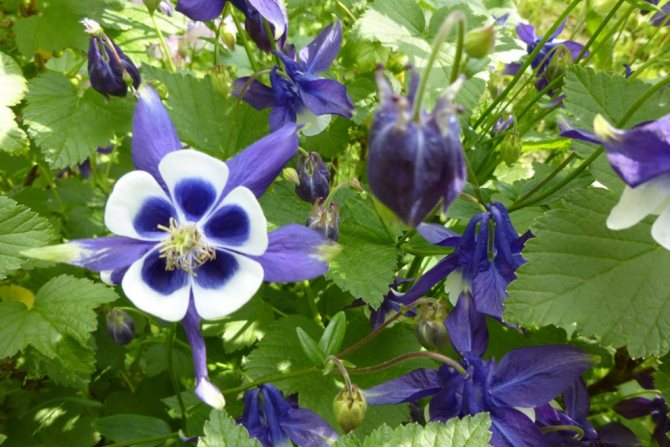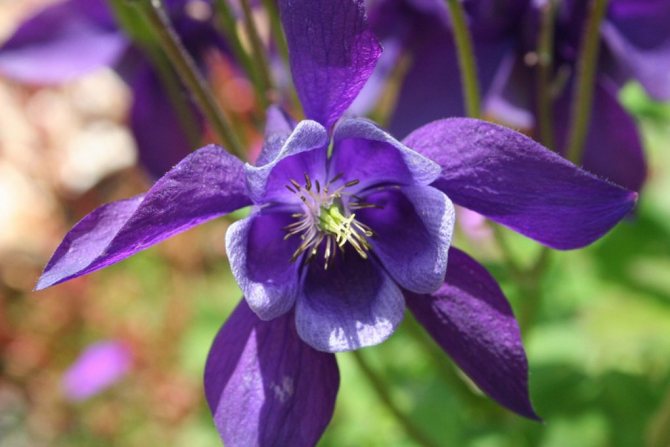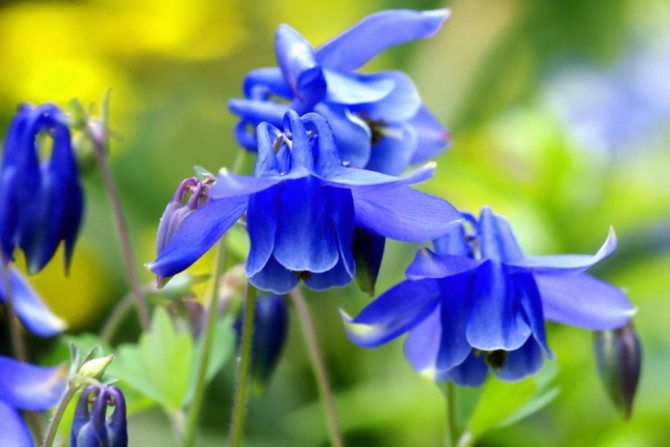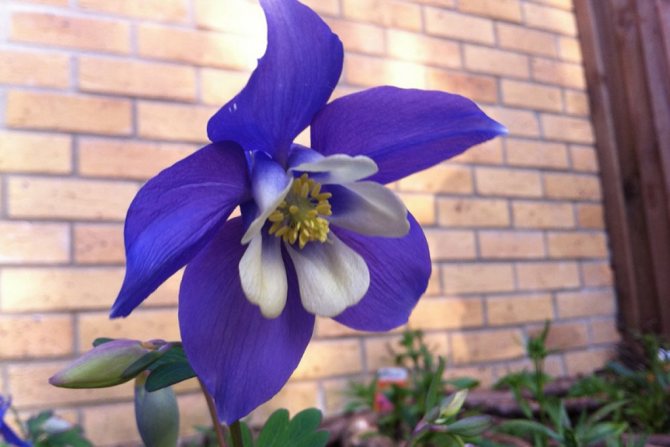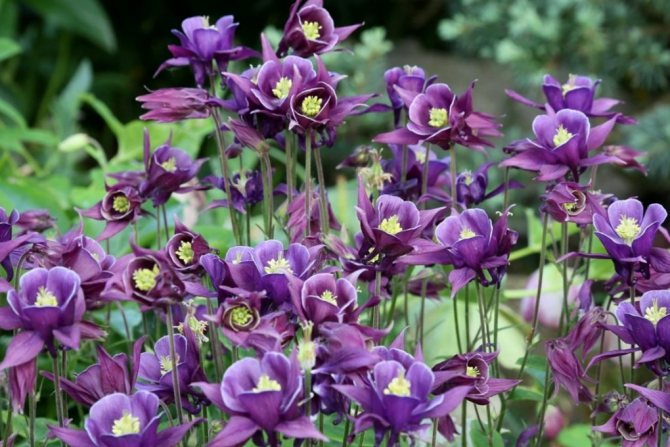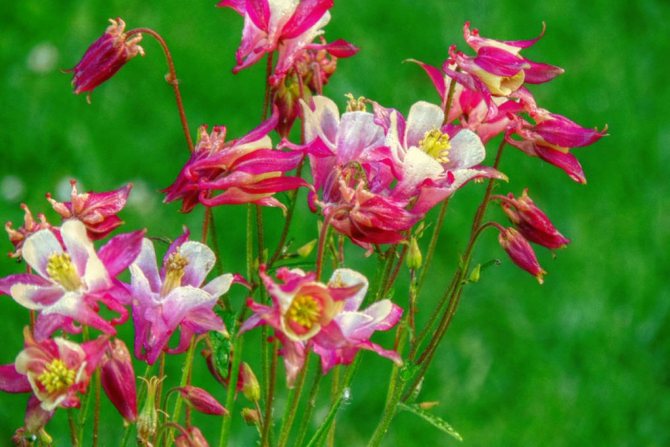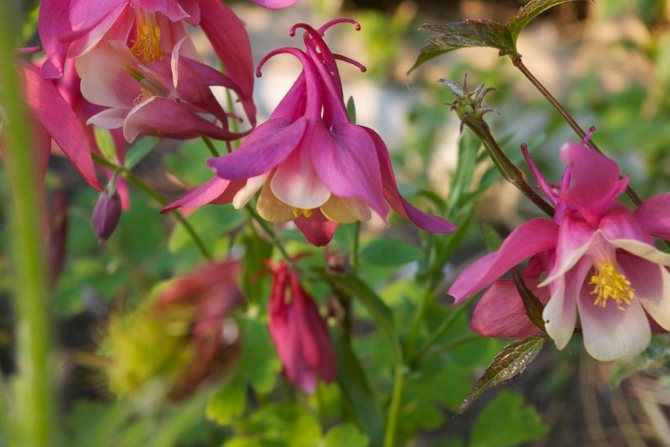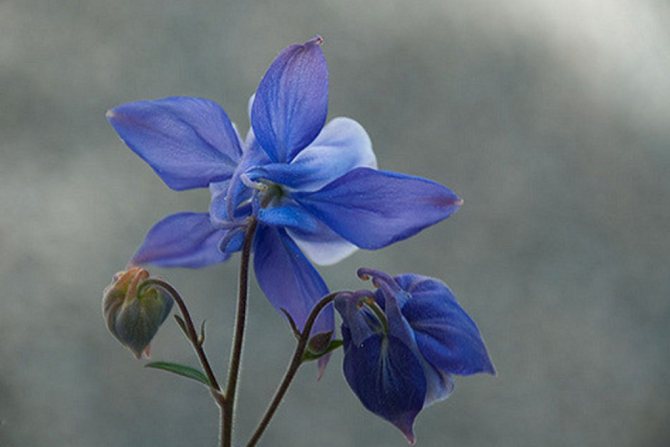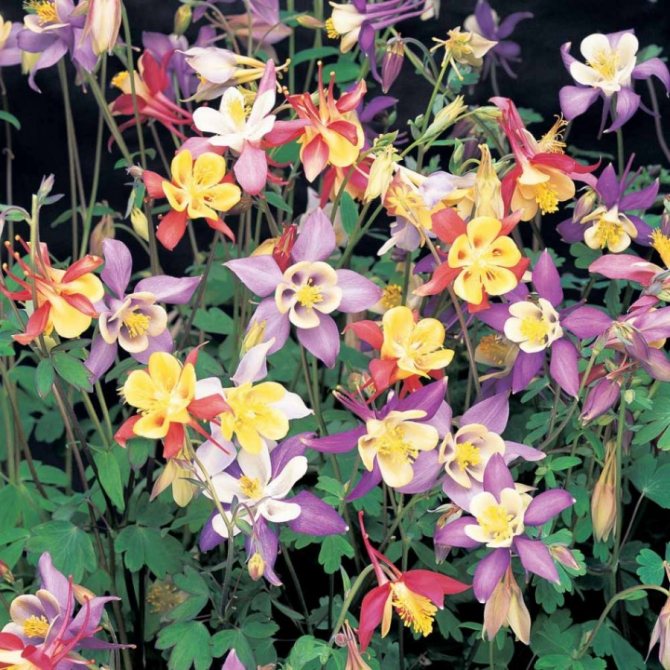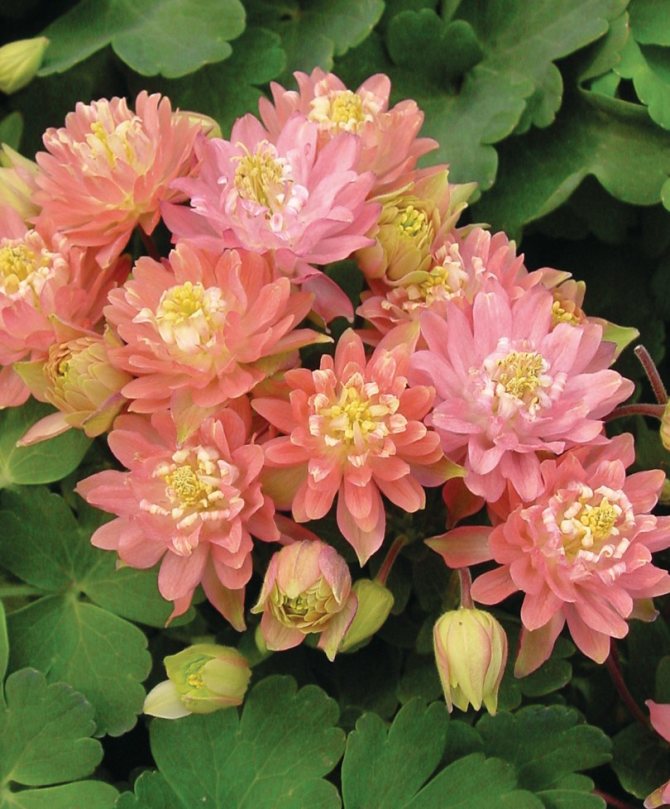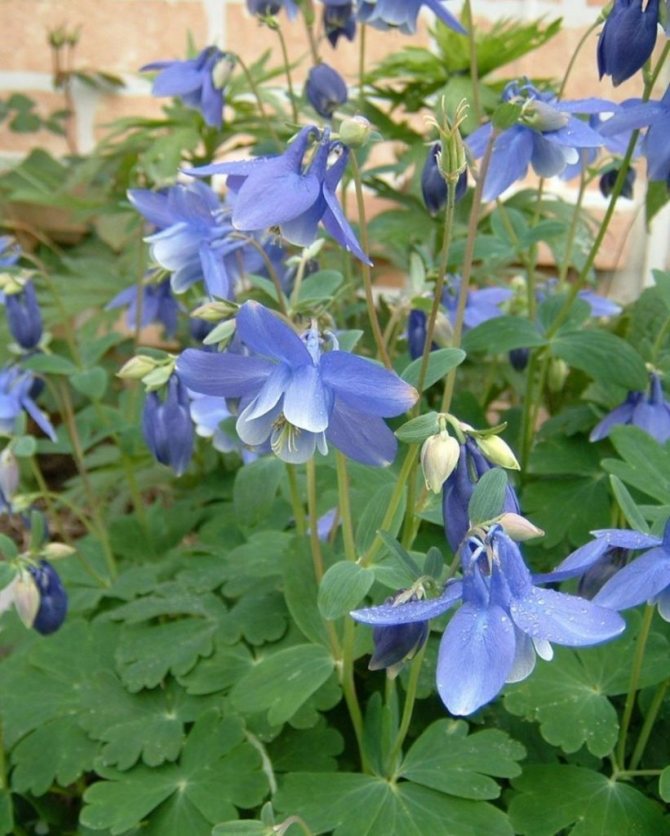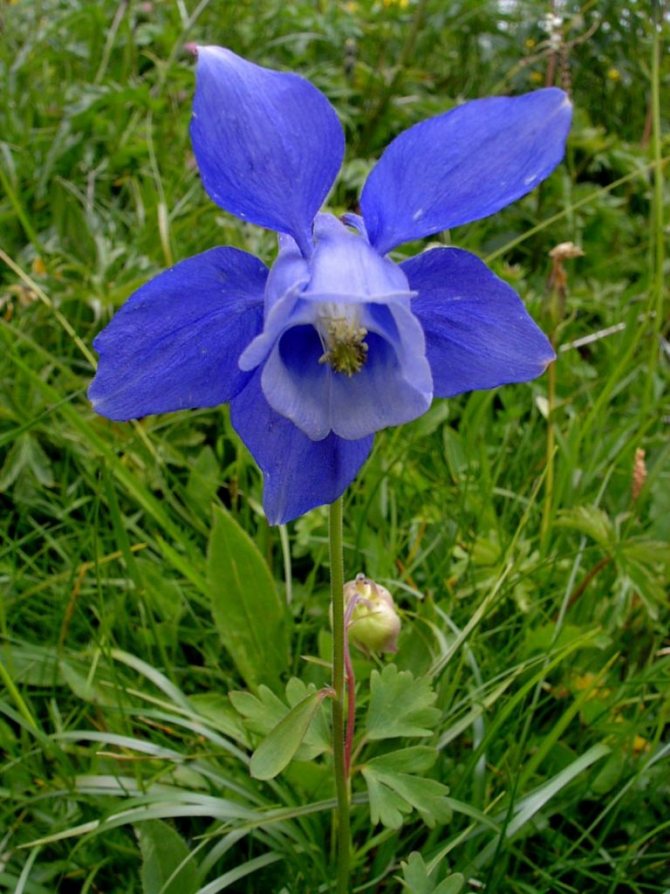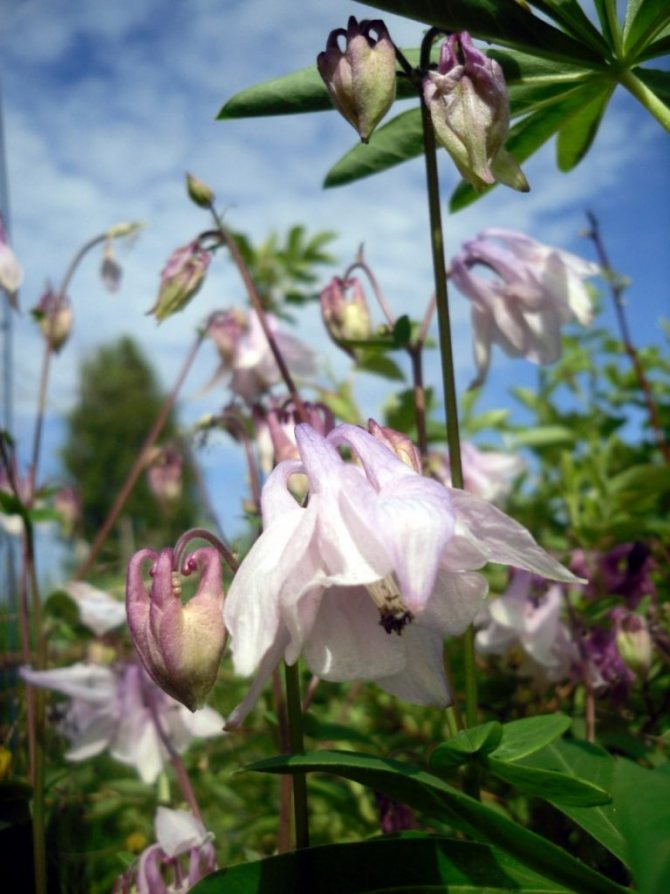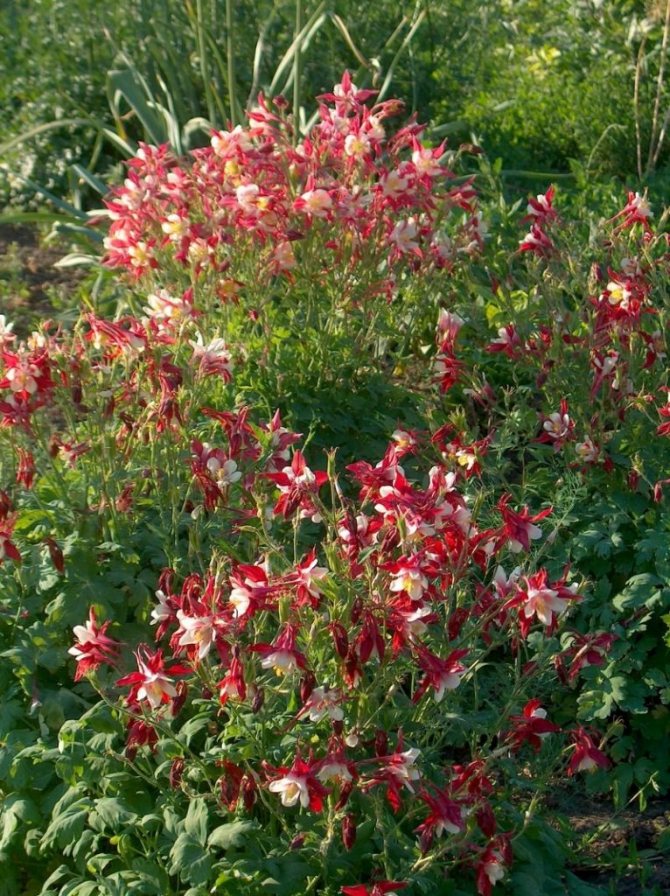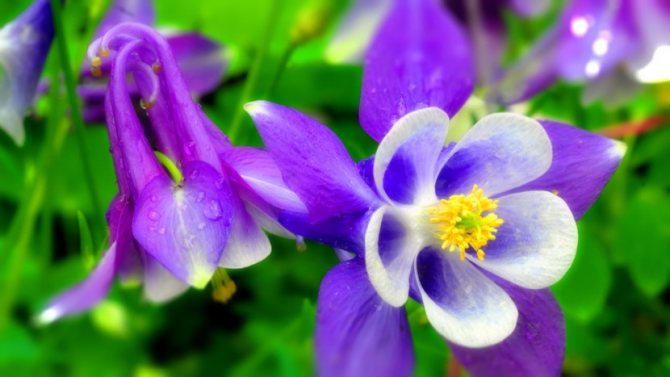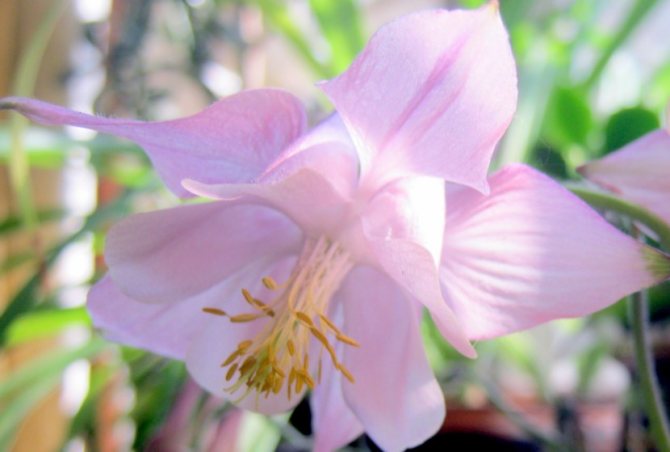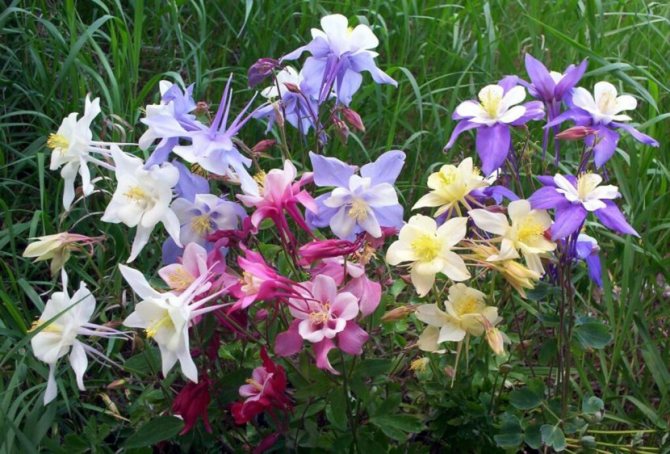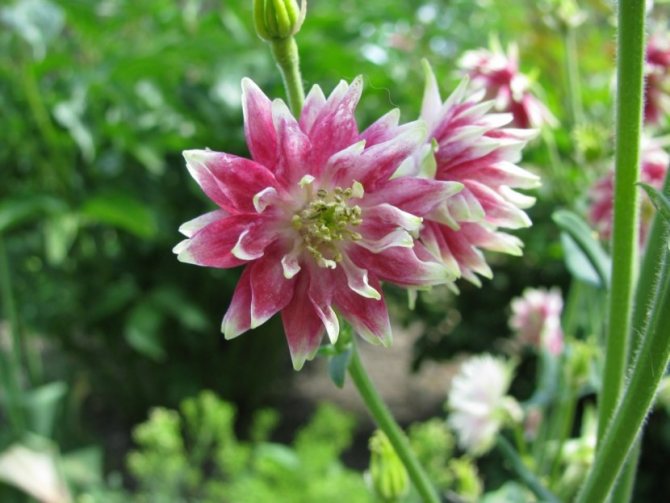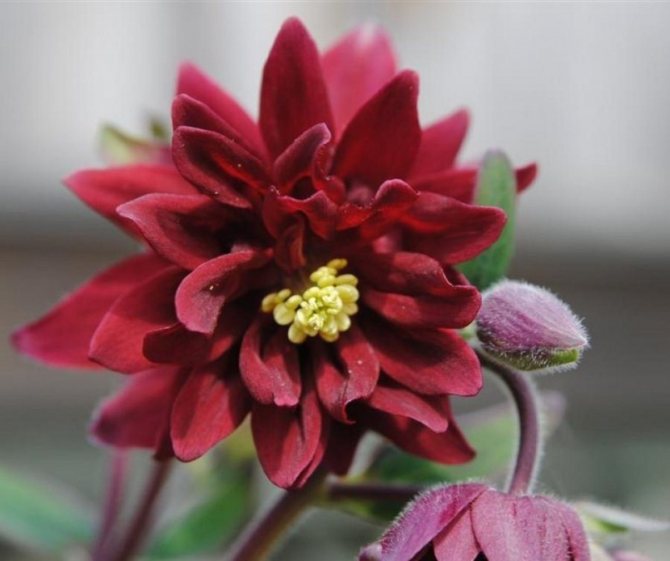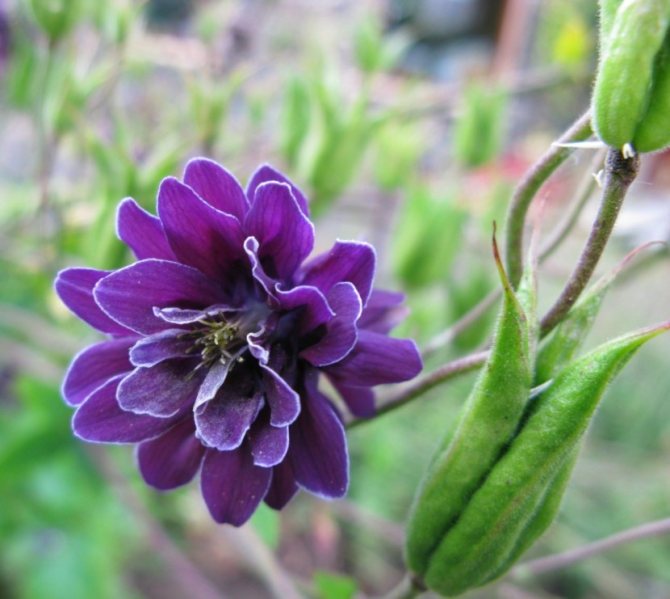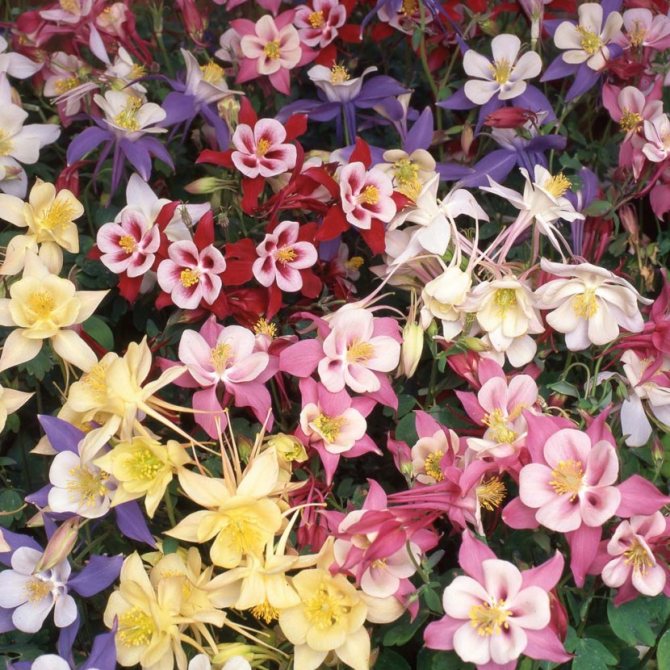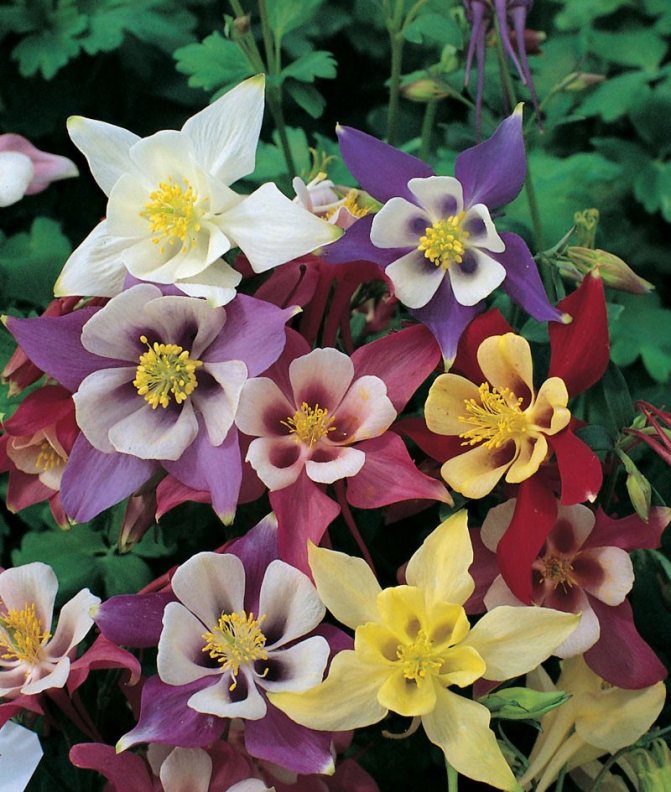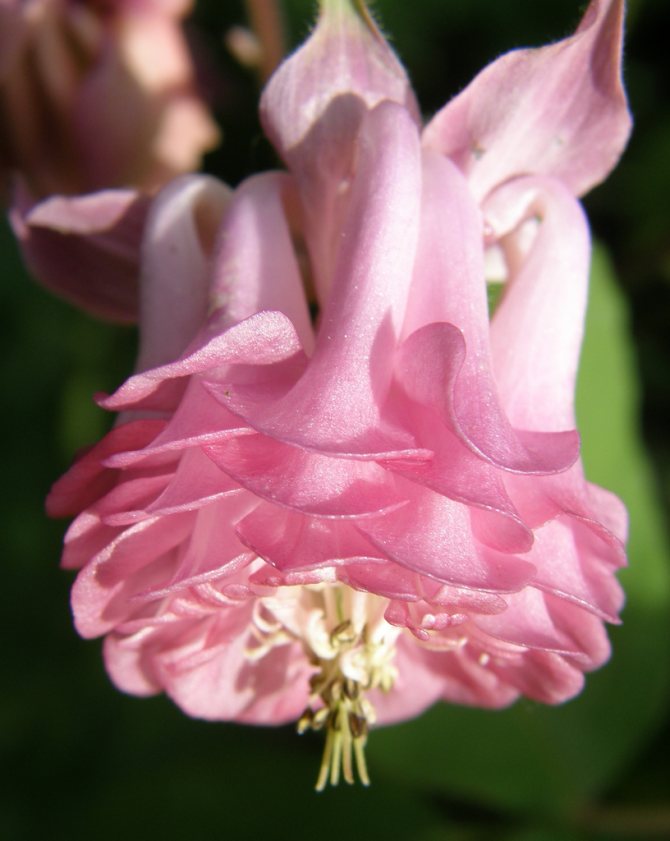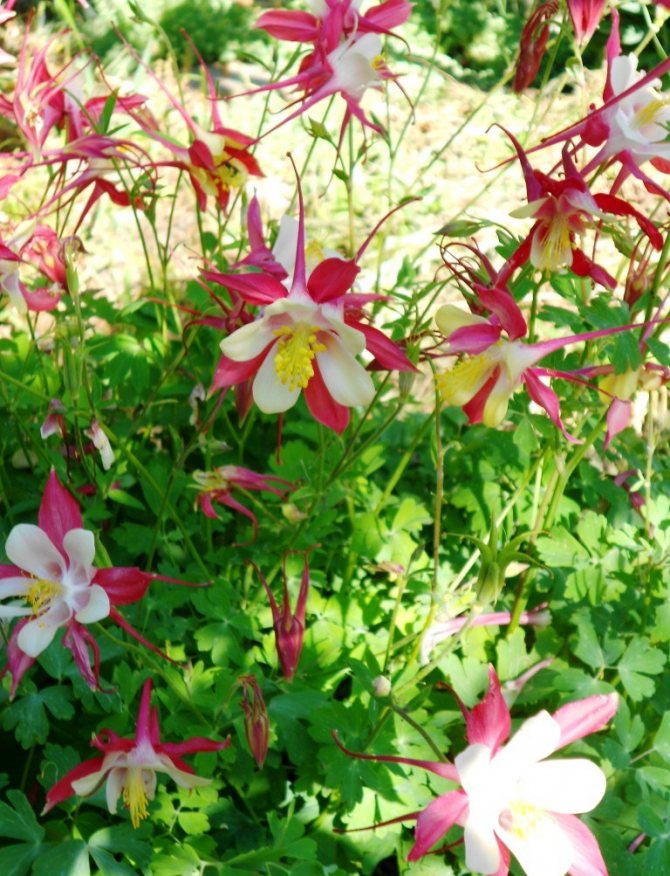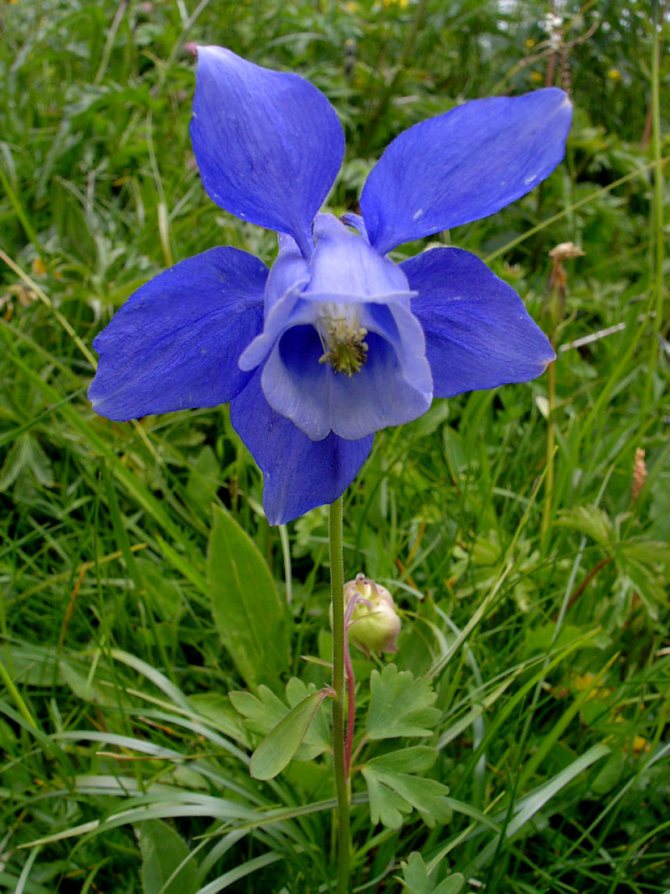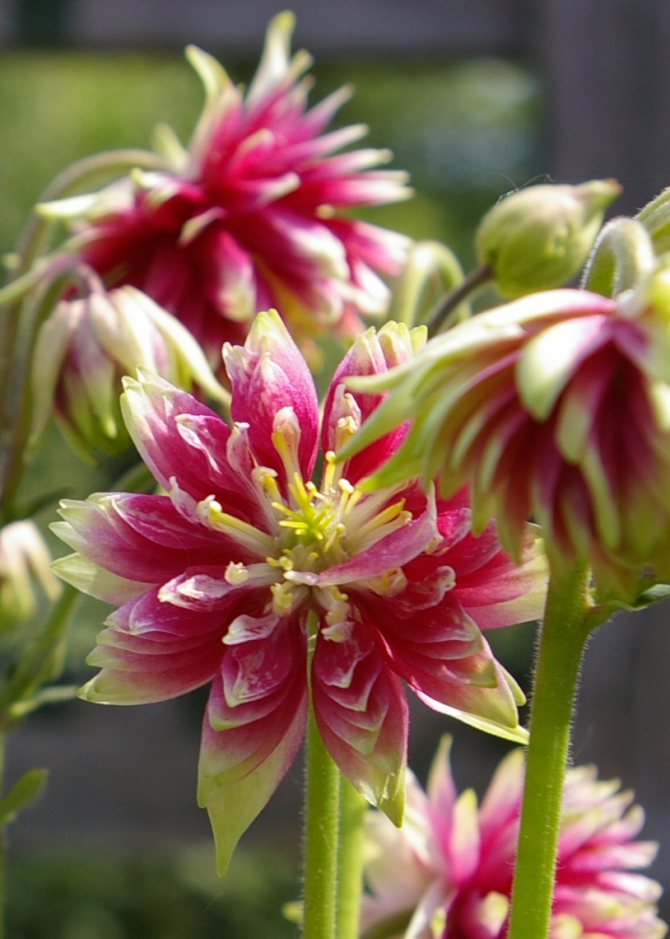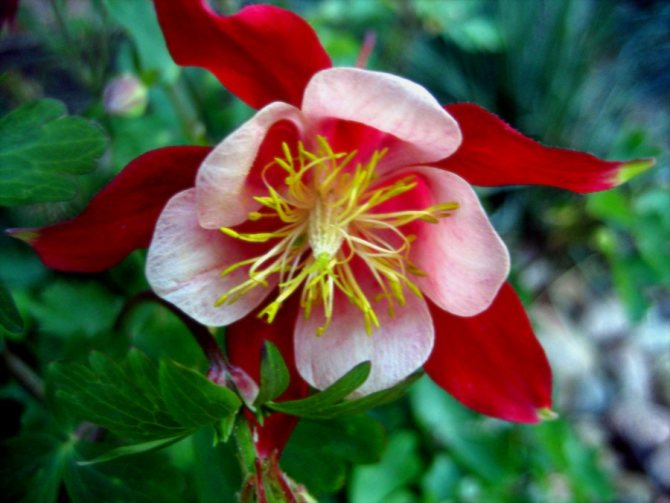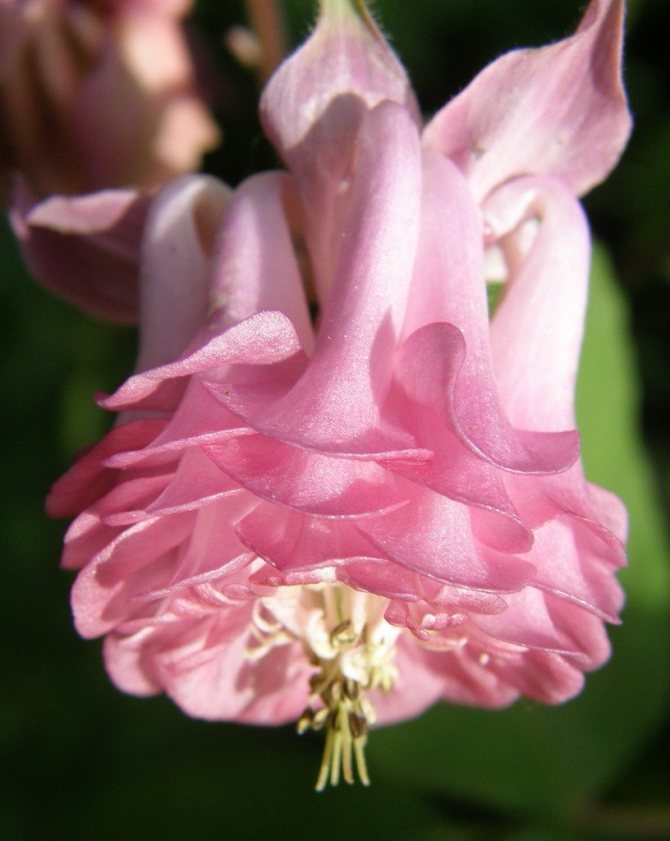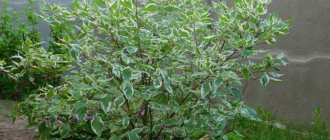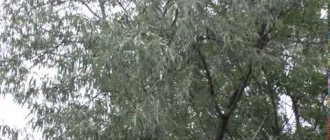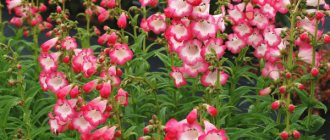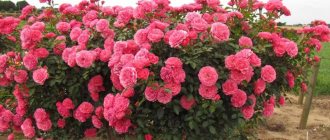A bright cap of flowers of an unusual shape and of various shades, towering on thin stems above bright green foliage, is aquilegia or catchment.
Delicate beauty, which has been decorating flower beds for a long time, has recently been forgotten by gardeners and landscape designers. However, interest in the original flower began to revive again and now aquilegia can be found everywhere, because it is not only beautiful, but also easy to grow. And the variety of species, forms and varieties allows you to create the most unusual plant compositions.

Aquilegia has a large number of names, many of which are based on popular beliefs:
- The catchment, eagle or dove in Russia. The eagle and the dove - in the shape of flowers and buds, resembling, depending on the degree of disclosure, a peaceful bird or a ruffled predator.
- Elf's shoe in Germany
- Slippers of the Virgin Mary or Columbine in English-speaking countries.
- Five birds in Australia.
And the common name "aquilegia" comes from two Latin words ("aqua", "legere"), translated as "water" and "to collect" or from one word "aquila" - "eagle".
Ancient myths and legends attribute a variety of properties to the beautiful aquilegia. It is believed that the plant is able to ward off evil spirits, is a symbol of peace and softens even the most cruel hearts. Aquilegia was often depicted in religious paintings as a flower of biblical pastures, on which all animals graze side by side. However, in some European countries, the catchment is called the flower of treason or a grumpy woman. It is believed that a decoction of the plant helps to calm down a quarrelsome woman.
There is also a completely practical, not related to superstition, benefits of aquilegia:
- In the cuisines of some countries, the plant is used as a seasoning for meat dishes.
- The catchment is a natural dye, therefore, in the Middle Ages, aquilegia was used both for dyeing fabrics and as ink.
- Stems and leaves of the herb, containing vitamin C and a group of alkaloids, are used in folk medicine to treat skin and stomach diseases, and also as a sedative.
[!] Due to the high content of alkaloids, aquilegia is considered poisonous. Therefore, despite the advice of traditional healers, it is not recommended to use it inside.
What is not in doubt is the beauty and grace of the vibrant colors of the aquilegia. The catchment is a welcome guest at any summer cottage.


To create the best conditions for a gentle beauty, you should learn about her better.
According to the botanical classification, aquilegia (lat.Aquilegia) is a genus belonging to the vast family of buttercups (lat.Ranunculaceae), and its closest relatives are buttercup, clematis, delphinium, basil, etc. It is a herbaceous plant with drooping bell-shaped flowers of a complex structure: a five-petal funnel-shaped calyx and spurs of various shapes and lengths, which are absent in some species. The color of the inflorescences can be very different: blue, purple, white, red yellow. Multicolor varieties are not rare either. The green part of the catchment will overtake no less beautifully: the bluish-green triple-dissected leaves with a long petiole form a lush bush that does not lose its decorative effect until late autumn.
Under natural conditions, aquilegia is found throughout the northern hemisphere - from North America to East Asia, and each region has its own plant species.
Aquilegia: varieties and varieties
Aquilegia has a fairly large family - it has more than a hundred varieties. The unusual shape and bright color of the flowers inspired the most original names for these plants: eagle, elf's shoe, dove.
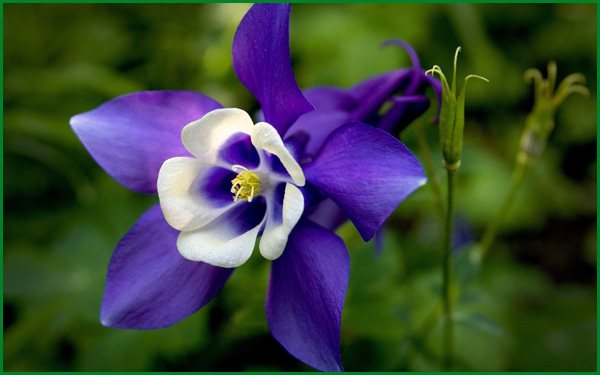

Alpine aquilegia
Let's take a closer look at the popular varieties for breeding in a personal plot:
- Alpine aquilegia is a low-growing variety. It has large blue flowers. The flowering period is in the first half of summer.
- Golden-flowered aquilegia - a distinctive feature of the variety - long spurs of bright yellow flowers.
- Canadian Aquilegia - This variety is notable for the fact that its flowers have two-colored petals of red and yellow hues.
Varieties of aquilegia
Among the wide variety of species in horticulture, only a small part of this plant is cultivated. The following types are most popular among gardeners:
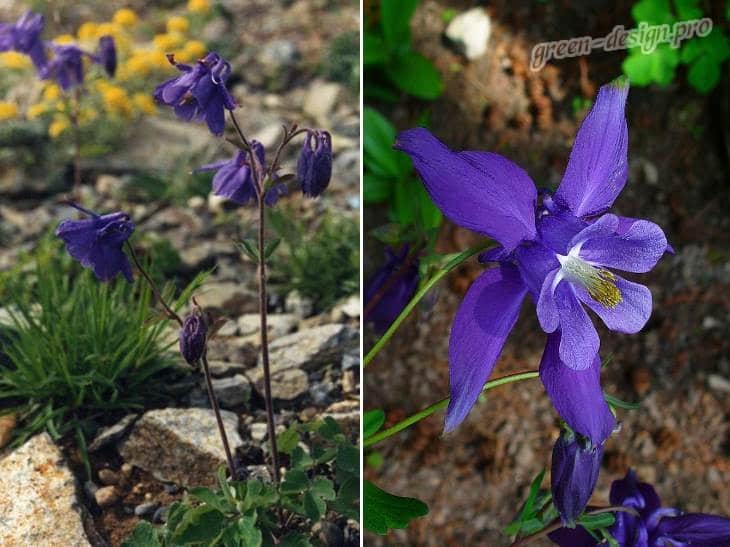

Alpine catchment
- Alpine catchment (Aquilegia alpine) - a plant of relatively short growth (up to 30 cm), but in some regions, with the mineralization of the land, the bush can reach up to 80 cm in height. The dusky head is colored in different shades of purple. The diameter of the leaf plate is 7-8 cm, the spur under them is of a short, curved configuration. Flowering: end of June, July.
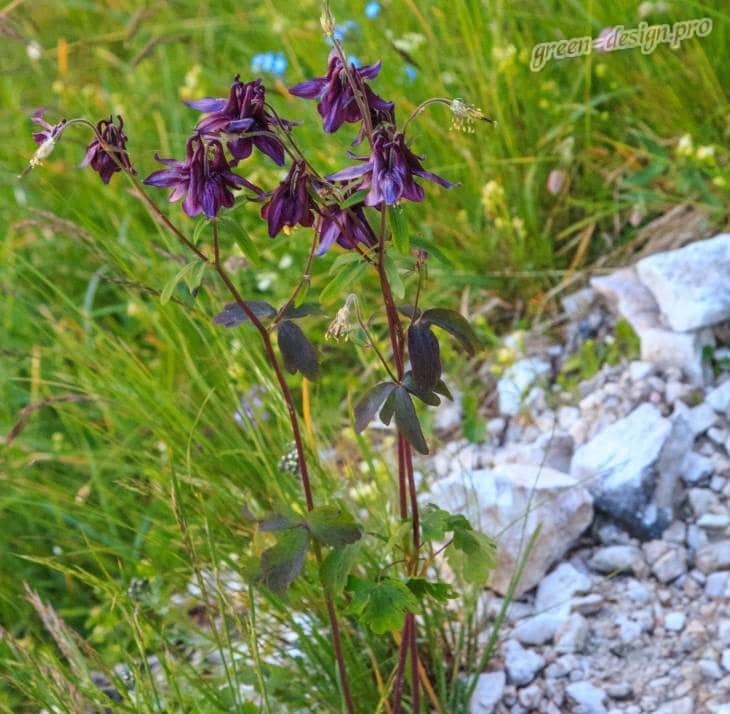

Dark aquilegia (Aquilegia atrata) - Dark aquilegia (Aquilegia atrata) is a European type of plant that reaches a height of more than 75 cm. The leaf plates are painted in a bluish hue, through which flowers of a dark purple color, 3-4 cm in diameter, penetrate. Short curved spurs act as stamens. The flower, although unpretentious to the conditions, reveals more colors when blooming in partial shade. The colored head opens at the end of May or the first half of June.
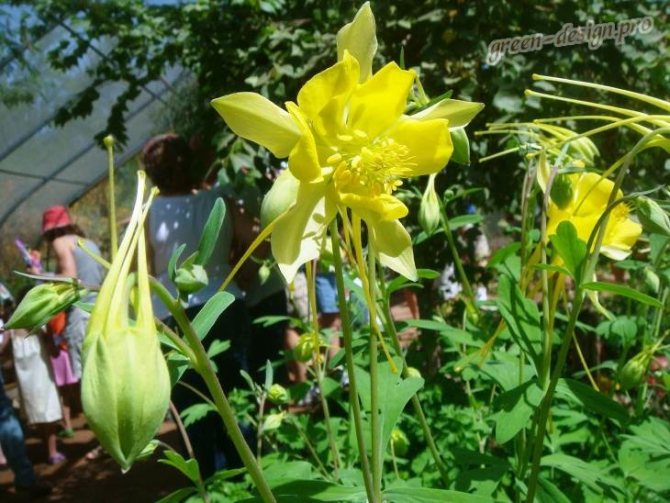

The catchment is golden-flowered (Aquilegia chrysantha) - The catchment is golden-flowered (Aquilegia chrysantha) - bright yellow flower, native to North America... At mid-climatic latitudes, it appeared relatively recently, but continues to gain popularity. Large flowers (95-110 cm in diameter) have long spurs. This species is characterized by high frost resistance and easily tolerates arid climate.


Aquilegia skinneri - Aquilegia skinneri is a native of North America. It has an unusually beautiful combined red-yellow color. Feature - high frost resistance, which promotes reproduction in the harshest climatic conditions. The plant can withstand up to -13 ° C.
Planting aquilegia
The best corner of the garden for planting aquilegia will be a partial shade area, protected from direct sunlight during the hottest hours of the day. Reproduction of perennials will be more successful on soil with a moderately loose and breathable structure. Before planting, it is recommended to dig it with compost and humus.
Aquilegia is easy to grow from seeds. Presowing preparation consists in the stratification of the seed. To do this, they are mixed with wet sand and kept in the refrigerator for a month.
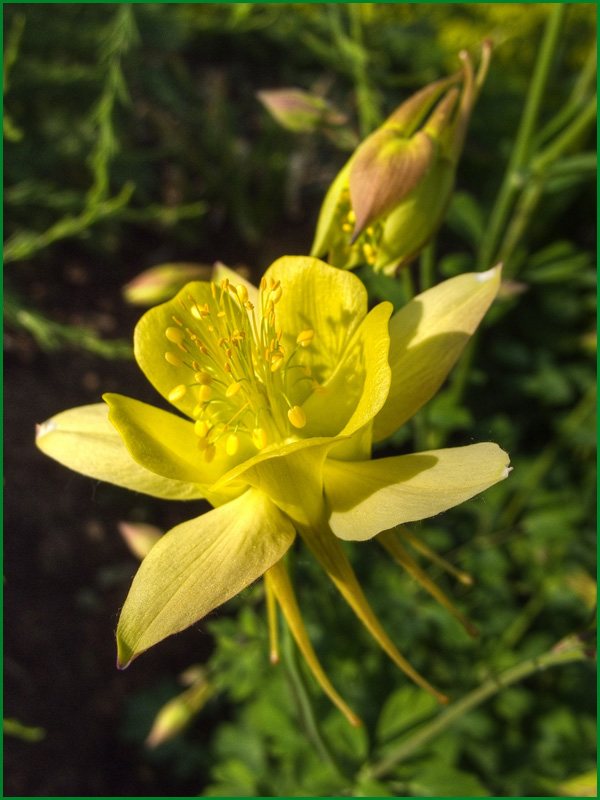

Aquilegia golden-flowered
Sowing in open ground is carried out in April-May under the film. The shelter is removed when the shoots hatch. Planting care consists of watering and weeding.
Advice. For 1 sq. the area of the flower bed should contain no more than 10 flowers. But given that not all seeds can germinate, the sowing density is increased. Later, excess plants can be transplanted to another location.
Growing aquilegia from seeds
The seeds of the plant are used for sowing immediately after they are harvested, that is, in the fall. However, if it was not possible to do this immediately, then it is better to store them until spring in a cold place, having previously mixed them with earth.
When spring comes, the seeds require washing, then they can be planted in boxes, in the so-called soil, consisting of equal proportions of sand, humus and leafy earth. A thin layer of soil is poured over the sown seeds and covered with newspaper or burlap. The aquilegia flower is a lover of shaded areas and relative warmth, no higher than +18, it needs constant light watering. The first shoots can be expected after two weeks. As soon as the first leaves appear on the horizon, this is a sign for planting seedlings over a wider area.
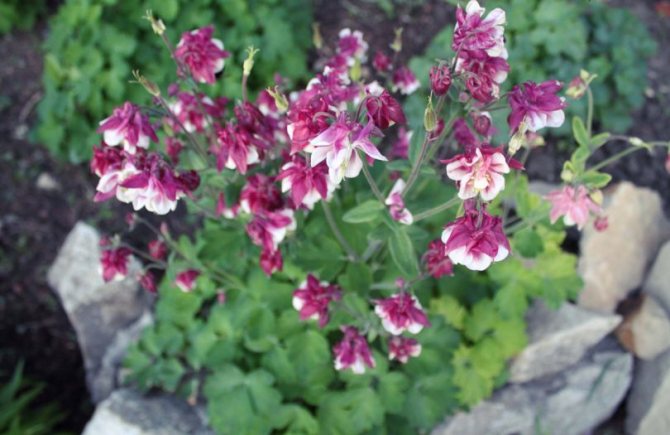

Aquilegia is a lover of shady places
Plant care
For those who place aquilegia perennials in their flower beds, growing and caring for a flower garden does not cause much trouble. The main concerns will be infrequent loosening of the beds, watering and weeding from weeds.
Advice. After watering, it is useful to mulch the soil with straw or dried cut grass.
A perennial can stay in one place without dividing and replanting for at least five years. To renew the soil under the bushes, it is enough to pour a little nutrient substrate under them from time to time.
Care
As already mentioned, this plant is not capricious, but like any representative of wildlife, it requires attention and care. For good growth, it is important to water the flowers of the catchment on time, fertilize (no more than twice in the summer season), if necessary, loosen the soil and be sure to get rid of annoying and destructive weeds. This is best done while the plant is immature and short.
Aquilegia is not only frost-resistant, but also drought-resistant, thanks to its root system, which is located deep in the soil.
As for fertilization, you can use mineral fertilizers (superphosphate, potassium salt and saltpeter) and undiluted mullein solution.
Fertilizing and feeding aquilegia
Perennial flowers in the open field with long-term cultivation in one place gradually impoverish the soil. Therefore, fertilization should be carried out for aquilegia for successful growth and bright flowering. The plant is fed three times per season:
- The first feeding with organic fertilizers is carried out in May - before the beginning of the flowering period.
- In June, when the buds have already dissolved their petals, a solution of nitrophoska or urea is introduced into the soil.
- When the perennial has faded, the flower bed is fed with fertilizers containing potassium.
Botanical description
Aquilegia is a herbaceous perennial plant. It has a branched rhizome, which consists of filamentous processes. It grows far in breadth and depth of the soil. Due to the peculiarities of the structure of the root system, adult bushes practically do not lend themselves to transplantation. The height of a flowering plant is 50-80 cm. A dense rosette of leaves is located at its base. The lower leaves have long petioles and a double or triple dissected leaf plate with rounded lobes. The length of the leaf is only 5 cm, and the width is 2-3 cm. The dark green leaves are covered with a waxy coating, so the water does not wet them, but collects in large drops. Stem leaves are trifoliate and sit tightly on the shoot.
In the first year of life, a dense rosette of leaves is formed above the ground. They persist even in winter under the snow, but die off in the spring. They are replaced by young leaves, and long peduncles grow from the center of the curtain. The smooth stem is rarely covered with lanceolate, trifoliate leaves. A single drooping flower blooms at the tip of each shoot. There can be up to 12 of them on one plant. The buds bloom in turn from the beginning of June. Each flower lives for about a week, and then it is replaced by the next.
The catchment flower consists of five funnel-shaped petals, on the back of which there are small spurs. The back of the corolla is decorated with lanceolate bracts with pointed edges. Often the petals and bracts are colored in contrasting tones, which makes the flowering even more attractive. The color of the corollas can be white, yellow, pink, scarlet, lilac, crimson, blue and black-violet. In the center there is a rather massive column, densely covered with short stamens.
After pollination of flowers, fruits are formed - many-leaved with small black seeds. They remain viable for 1-2 years. It is important to be careful as aquilegia seeds are poisonous.
Plant propagation
In addition to growing from seeds, they use vegetative propagation methods for aquilegia. When the plant is dormant, you can start reproduction by dividing the rhizome. To do this, in early spring or late autumn, perennials are dug out of the soil and the root is cut lengthwise.
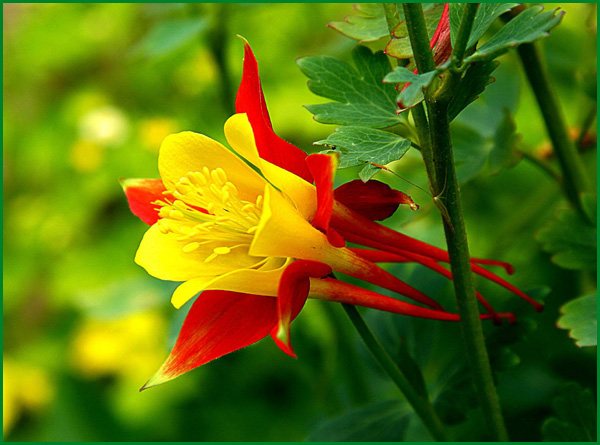

Aquilegia Canadian
The incision is made in such a way that a kidney is preserved on each division. The disembarkation is carried out on the same day. Caring for them consists in regular watering.
Important. If sick, rotten places are noticeable on the rhizome, they must be cut off and treated with crushed charcoal.
Aquilegia reproduces well with green cuttings. This procedure is carried out in the spring, when the plant has entered the growing season. The place where the cuttings are cut for propagation should be treated with a rooting stimulator. Chemical preparations will successfully replace the juice of aloe leaves. The cuttings are rooted in a container of wet sand under a glass jar.
General characteristics of the plant
The catchment is also popularly called the eagle, and in scientific circles the plant has a beautiful name - aquilegia. Official information indicates that the flower develops well only in the mountainous regions of the Northern Hemisphere, but in practice it has been proven that aquilegia is well accepted in all regions. There are more than 100 plant subspecies, but only 36 varieties are cultivated in modern horticulture.
Most often the catchment is blue, but there are other colors.
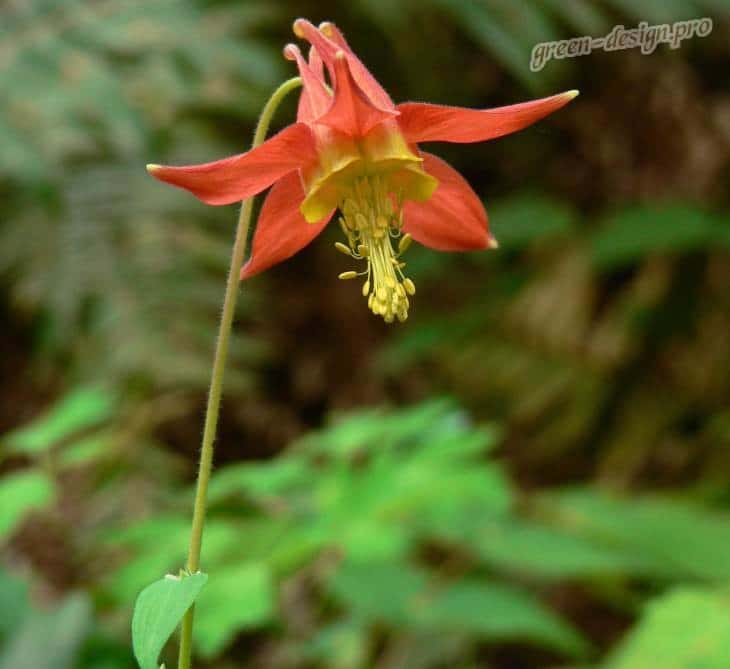

Outwardly, the catchment flower has the shape of an open bell, in which rosette color plates with a peduncle are placed.
The flower plates are distinguished by long petioles, which are dissected into trifoliate sessile leaves. Single peduncles, which are formed from the center of the rosette plate itself, depending on the variety, have pink, crimson, white, blue, purple and even mixed coloration, but yellow is most often found.
Spurs are placed under the bell-shaped plates - hollow outgrowths of sepals with nectar. Only Chinese and Japanese plant varieties do not have such "chambers". Aquilegia bears fruit with small black seeds, which are located in a developed capsule - a multileaf. The seeds are poisonous, so you need to be careful when handling flowers when they bear fruit.
Diseases and pests
In order to protect aquilegia from damage by diseases and pests as much as possible, it is necessary to follow the rules of planting and care in the open field. Mistakes in which these perennial flowers are cultivated in a poorly lit area or over-watering lead to the appearance of powdery mildew symptoms on the leaves. Such plants will require frequent treatments with a sulfur solution.
The content of aquilegia in dampness threatens the development of gray rot. It can be recognized by the brown, depressed spots on the leaves, which eventually spread to the stems and flowers. Spraying with a solution of potassium permanganate or other available fungicides helps to defeat the fungus.


Group landing of aquilegia
Aphids like to settle on aquilegia. Treating plantings in open ground with soapy water helps to get rid of the parasite.To do this, rub 300 g of laundry soap on a coarse grater and dissolve this shavings in 10 liters of water.
You can drive away aphids from the flower bed by spraying water boiled with ash. In addition to fighting the pest, these procedures are an excellent top dressing for a flower garden.
Advice. To make flower gardens less annoyed by pests, it is worthwhile to reproduce insecticide plants. In particular, parasites bypass flower beds where marigolds are grown.
Planting and leaving
Reproduction of aquilegia is carried out both by seeds and by dividing the root system.
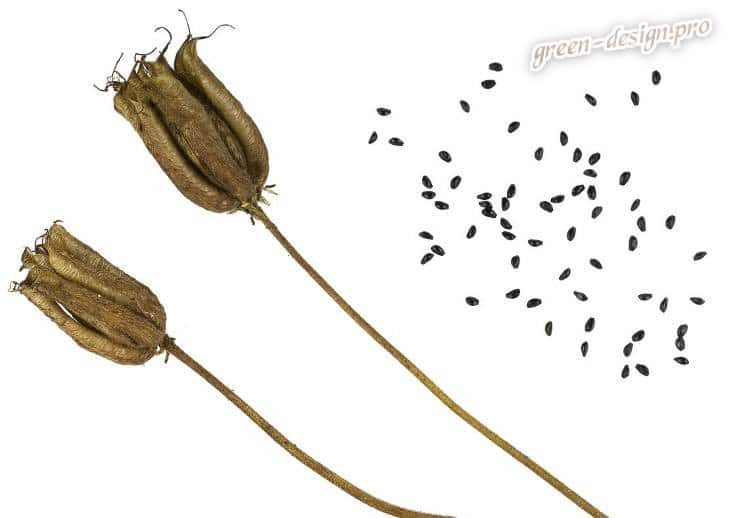

Catchment seeds
If you use the second option, then with an instant transplant, the flower may get sick and simply not take root in a new place. This is due to the peculiarity of the structure of the root, which develops with a core. To prevent such a situation, after splitting the root, it is recommended to place the separated parts in small containers, sprinkle with crushed coal for a while. Thus, the culture will receive the necessary minerals and will be able to fully develop in a new place.
Care for the catchment is simple - you will need to loosen the soil in a timely manner, remove weeds and water during severe droughts. Superphosphate (no more than 50 g per 1 m²) or saltpeter (25 g per 1 m²) is suitable for feeding. Over the summer, you will need up to 2 dressings.


Cultivar Aquilegia 'Blue Butterflies'
Among the diseases in aquilegia, gray rot, rust and powdery mildew are often observed. Affected crops are pruned or removed completely. To fight the fungus, use a solution of green soap with colloidal sulfur.
The catchment can be attacked by aphids, spider mites, and scoops. To eliminate pests, they use Karbofos or Aktellik. To prevent the attack of insects, cereals can be planted next to the plant.
Aquilegia: combination with other plants
Aquilegia is very friendly to neighbors, and it is not at all difficult to find a combination for it with other plants. The photo of these flowers is replete with various colors, therefore, when drawing up a scheme for a decorative flower bed, there should be no difficult questions about which perennial plants to place nearby so that their neighborhood in the open field is harmonious.


Aquilegia surrounded by ornamental foliage crops
Most organically in landscape design, aquilegia is combined with flowers as graceful in appearance as it is. She can be paired with bells, poppies, carnations, swimsuits, saxifrage.
Advice. At the same time, the delicate structure of the flower will be emphasized by coarser and more massive plants like badan, hosta, fern.
To play on the contrast, slender tall lupine candles are grown next to the spreading cap of aquilegia flowers. An interesting solution in landscape design would be to choose varieties of these perennials of the same color to decorate garden paths and ridges.
Aquilegia flower. Description, features, types and care of aquilegia
A bouquet of Aquilegia is an insult. This is how Americans perceive a gift with flowers from the Buttercup family. In the United States, Aquilegia represents female infidelity. Among the peoples of Europe, the symbolism of the flower is softer, but also associated with sensuality.
In the Scandinavian region, for example, Aquilegia - Freya's attribute. This is the Goddess of love and fertility. However, the plant is capable of killing the fruit of love. The inhabitants of the Middle Ages used tinctures from Aquilegia seeds for termination of pregnancies.
Therefore, the flower and began to associate with the themes of temptation, harassment. After all, it was not customary to get rid of children conceived in marriage. All in all, glory aquilegia plant found ambiguous.
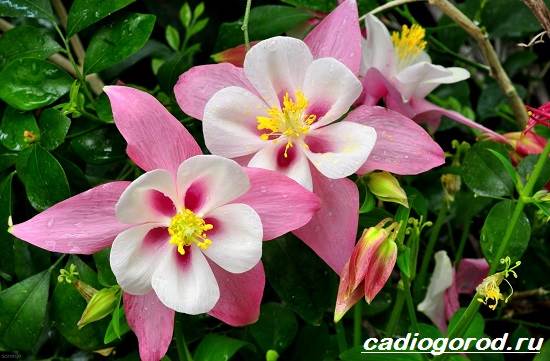

In the photo sowing aquilegia
Meanwhile, the flower is beautiful and delicate in appearance. In the 21st century, it is customary to discard prejudices. Therefore, flowers Aquilegia appear more and more often, if not in bouquets, but at least in gardens. Let's walk through them.
Description and features of Aquilegia
Aquilegia not only belongs to the Buttercup family, but is a whole genus in it. In other words, we are talking about many colors, united by structure. It is complex, little reminiscent of Buttercups, with which Aquilegia is related.
The buds of the heroine of the article are composed of 5 petals. They are separate, twisted into funnels. Botanists call their bottom spurs. They are curved or straight. The spurs reach 4 centimeters in length. However, there are varieties without funnels.
Complexity to the buds of Aquilegia is given by a series of sepals. To the layman, they are indistinguishable from petals. As a result, it seems that there are about 10 of them. Sepals are bent to the sides, pointed at the ends, resembling a star. Ordinary petals are located in its center, making up a funnel. I see on the picture.
Aquilegia appears as a flower, in the buds of which water often gleams. The ability to hold it was the reason for the Latin name of the plant. Aqua, as we understand it, means "water". Legere is translated as "to collect". In the Russian way, the grass is called the catchment.
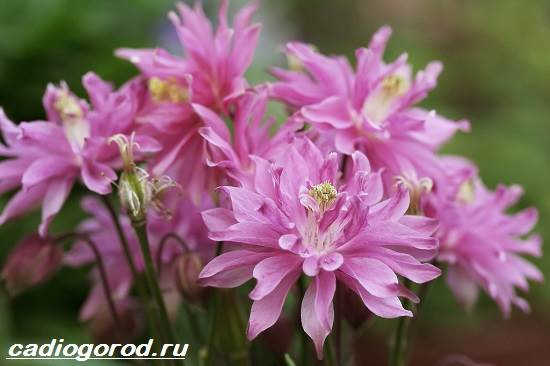

In the photo, aquilegia is terry
By color of flowers Aquilegia "Ordinary" extraordinary. Most species have two-color buds. The funnel may be yellow and the spurs purple. If the tubules of the petals are red, the core may be white. There are also combinations of scarlet with gold, plum and lilac.
Aquilegia home, like the garden one, is inclined to lower the "heads". The buds droop, turning their spurs up. Hence the doubts of scientists whether it is a catchment.
In inverted flowers, liquid does not retain. Perhaps the herb is named after the Latin word aquila. Translation - "eagle". The curved spurs of the petals resemble the claws of a bird.
In addition to the buds, the leaves of the heroine of the article are decorative. Growing aquilegia outdoors with greenery and begins. The buds bloom in the 2nd year. In the first of them, only a rosette of leaves appears. They are triple, long-stemmed, rich in color.
On the peduncles of Aquilegia, there are also leaves, and also dissected. However, the upper greenery has no petioles. The leaves are attached directly to the stems. Appearance is attractive not only to humans, but also to insects.
They are happy to pollinate the plant. Nectar is collected in the funnels of the petals. It is sticky and does not leak even when inverted. Eventually, planting Aquilegia becomes spontaneous. Cross-pollination produces hybrids with unpredictable bud colors. Some give 1 peduncle and some give 2.
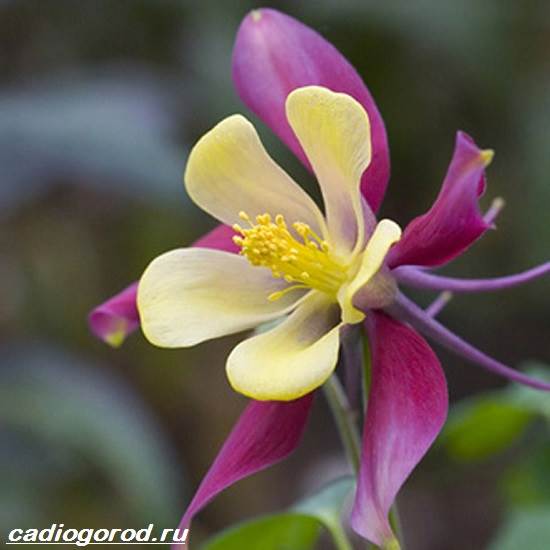

In the photo, aquilegia hybrid
Aquilegia at home grows everywhere, but in nature it is found only in the northern hemisphere. In Russia, the plant is found in Primorye. In the United States, Aquilegia is the symbol of the state of Colorado. In China, the flower was chosen by Manchuria, it is also found in Japan, as well as in most European countries.
Types and varieties of Aquilegia
Under natural conditions, about 100 species of the heroine of the article grow. Cultural Aquilegia varieties withdrawn from 35 of them. Plants are conventionally divided into American, European and Japanese.
The latter lack spurs. European flowers have them, they differ in a hook-shaped edge. Seedling Aquilegia American is distinguished by long, but straight spurs.
Whichever territorial category Aquilegia belongs to, hybrid varieties are popular. They are obtained by crossing different species, taking in the best from both.
On packages with seeds Aquilegia hybrid denoted by the letter F. The number "1" must be presented to it. This means that the seeds are taken from the first generation hybrid.
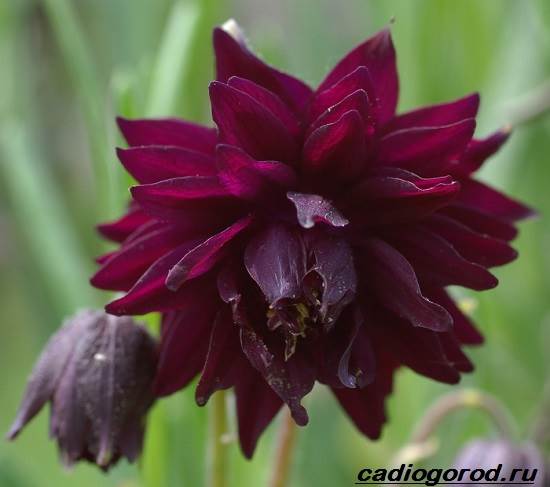

In the photo, aquilegia ordinary Black Barlow
In subsequent generations, varietal properties are lost. This is a minus of hybrid seeds, because Terry aquilegia can lose velvety down, and multi-colored buds become monochromatic.
But the variety "Mr. Scott Elliott", for example, has buds with a diameter of 10 centimeters. Hybrid Aquilegia "Winky" pleases with flowers of the original form.They resemble roses. Aquilegia "Barlow" terry. The variety also differs in the almost black color of the petals. The full name of the plant, by the way, is Aquilegia "Nora Barlow ".
Hybrid grass varieties, as we understand, does not make sense to propagate by seeds. From ordinary varieties of Aquilegia, they can be collected and put into growth. The seeds of Foxtrot will produce equally tall shoots.
They will grow up to 75 centimeters and give terry buds. The younger generation of the Tauer variety will also be tall. It stands out with indigo buds. The flowers of "Tauer" reach 5 centimeters in diameter.
There are several reasons why conventional varieties are preferred over hybrids. In addition to the decorative qualities of plants obtained from the crossing of different species, demands are captivating.
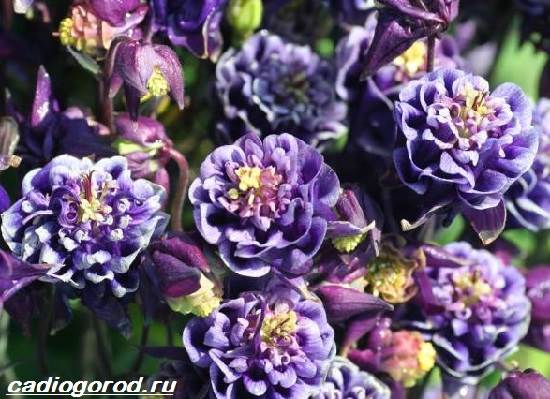

In the photo aquilegia Winky terry
Hybrids are unpretentious in care, resistant to diseases, temperature extremes. Aquilegia "Ordinary", for example, is experiencing -35 degrees. Accordingly, the perennial flower winters successfully even in Siberia. Some varieties require covering for the frost period with straw and foil. However, we will talk separately about caring for the heroine of the article.
Growing and caring for aquilegia
Planting Aquilegia in the ground occurs in autumn or spring. The material is placed in the frozen ground for quenching. After it, the seeds give healthy, strong shoots.
However, many are afraid to place grains in open, also frozen ground, stratifying the house. First, the seeds are placed in moss moistened with cotton wool or sand, and then in the refrigerator. There, at a temperature of 0- + 4 degrees Aquilegia and harden.
Stratification takes 2-4 months. Accordingly, we calculate the period of placing the seeds in the refrigerator, starting from the planting time. It is preferable to plant Aquilegia outdoors. This additionally hardens the grass. The seedlings of the flower are more tender, they are more often sick.
It makes sense to propagate the heroine of the article with seedlings when there is a shortage of seeds. Plants planted in open ground are strong only because weak seeds do not germinate. In sparing conditions of an apartment or house, germination is higher.
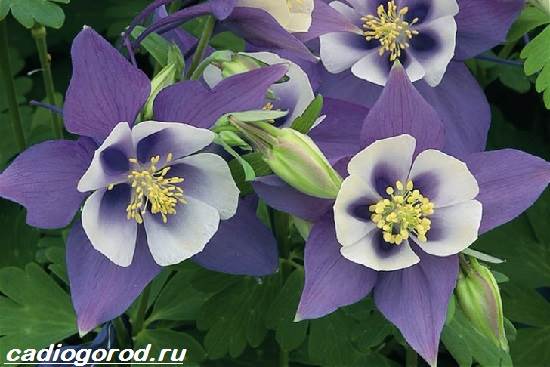

In the photo aquilegia hybrid blue
90% of seeds go into growth. Only about 60% survive outdoors. If you need to fill a flower bed, and there are only 3 bags with grains, it is logical to resort to the seedling method.
So, the answer to the first point of the question is given, how to grow Aquilegia? The seeds, by the way, are soaked before planting. It is enough to soak in water for a day. After that, the seeds are distributed every 6-9 centimeters into 1.5-2-centimeter depressions in the soil. It remains to sprinkle the grains with a mixture of sand and earth.
Breathable fabric covers the landings. Water over it. Matter should be removed with the appearance of the first shoots. They don't like bright sun. Therefore, shaded areas are chosen for planting Aquilegia. Only in the twilight does the heroine of the article bloom violently and for a long time.
Aquilegia care also touches upon the question of the substrate. The flower loves light and loose. Therefore, the soil near the plants is periodically dug up and fertilized with compost. You can feed Aquilegia and humus. The flower does not need mineral fertilizers, taking everything it needs from the soil.
Aquilegia fertilizers are applied every spring. It can also be added before growth and after flowering. In the latter case, the grass no longer needs strength to form buds and gain green mass. Therefore, by the fall, Aquilegia gives mineral complexes instead of organic matter. However, as already mentioned, you can do without them.
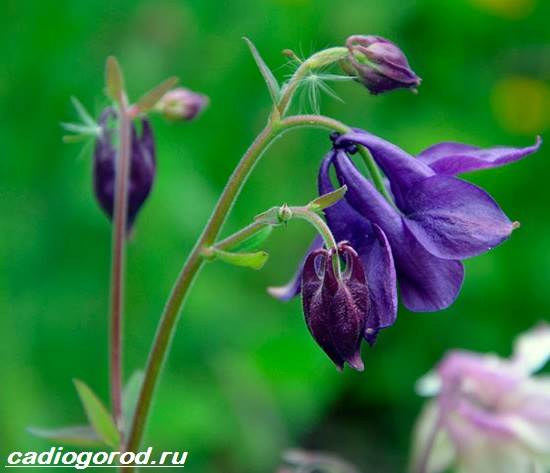

In the photo alpine aquilegia
Aquilegia, like other plants, needs a certain set of nutrients. Growing in one place, the flower pulls them out of the ground for the 5th year. It is necessary to change the location of the grass. Fortunately, it is undemanding to neighbors and predecessors.
Watering Aquilegia needs moderate. The heroine of the article is, in principle, moderate in her requests. Buy Aquilegia even for inexperienced gardeners. Already during the period of active growth and droughts, they will guess to water the grass.
At other times, Aquilegia receives the necessary moisture from rain and groundwater. However, weeds also apply for water. It is difficult for the heroine of the article to compete with them. So, regular weeding is needed.
The hassle of caring for Aquilegia is added by its height. Some varieties reach 80 centimeters. The stems of flowers do not become thicker from this. Props required.
Without them, Aquilegia begins to creep along the ground. This encourages knowledgeable gardeners to purchase undersized flower varieties. Plants with a height of 30-40 centimeters confidently stretch towards the sun.


In the photo aquilegia of the Mc Kana variety
If the shoots need support, twine or plant vines are used. Other props - risk of damaging thin and delicate stems Aquilegia... They touch it only when necessary, for example, removing wilted buds.
Cutting them gives the plant the strength to form new flowers. By the way, they keep on the shoots for about a month. If you also cut off the old flower stalks, you can admire the buds until autumn.
Excess flower stalks of Aquilegia are cut off, but root rosettes of leaves are left. Recycled material comes in handy as a compost component. If diseased plants are removed, they should be removed from the site and burned.
The heroine of the article can harm the heroine of the article. It's a butterfly. It is associated with Aquilegia in the caterpillar stage. The creature, green with white stripes on the sides, eats the grass. But, plantings treated with sprays against leaf-gnawing caterpillars, Metalovidka does not touch.
Of the fungal diseases, Aquilegia suffers from Alternaria. It manifests itself in brown spots on the greenery of the flower. The marks gradually lose moisture. Dry areas brighten and fall off. In order to avoid contamination, Aquilegia is sprayed with "Bordeaux" mixture.
There is another fungus that is interested in Aquilegia. This is powdery mildew. It is named so because of its appearance, similar to the bloom of flour on the leaves. The parasite infects young foliage.
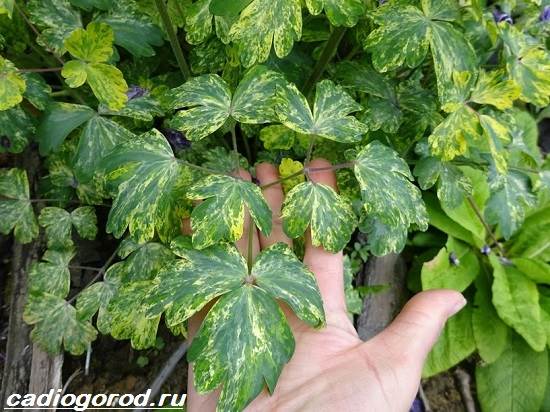

In the photo, aquilegia ordinary Leprikon Gold
She will be able to avoid the bitter fate by being treated with colloidal sulfur. By the way, it also scares away ticks. Aquilegia is not affected by the latter, but it is worth playing it safe.
Aquilegia price
If you look at it from the point of view of beliefs and legends, then Aquilegia can be both priceless and penny. The first case concerns the Christian view of the plant. The flower serves as an image of the Holy Spirit. In some sources, the heroine of the article is called the shoe of the Virgin Mary.
Not worth the price of Aquilegia, if you believe the beliefs that originated in Ancient Greece. The spurs of the flower resembled phalluses to its inhabitants. So Aquilegia became a symbol of Aphrodite, and then, and lust. Over the centuries, the flower has been recognized as a sign of courtesans. Nobody wanted to pay for the symbol of a corrupt profession, as well as to grow a water reservoir for free.
In the 21st century, people are ready to pay for Aquilegia. The cost of seeds depends on the variety and volume of the pack. As a rule, there are 10 grains in a package or 0.1 gram. The price of seeds starts from 16 rubles. The most decorative, sophisticated varieties cost 150-200 rubles per package of 5-10 seeds.
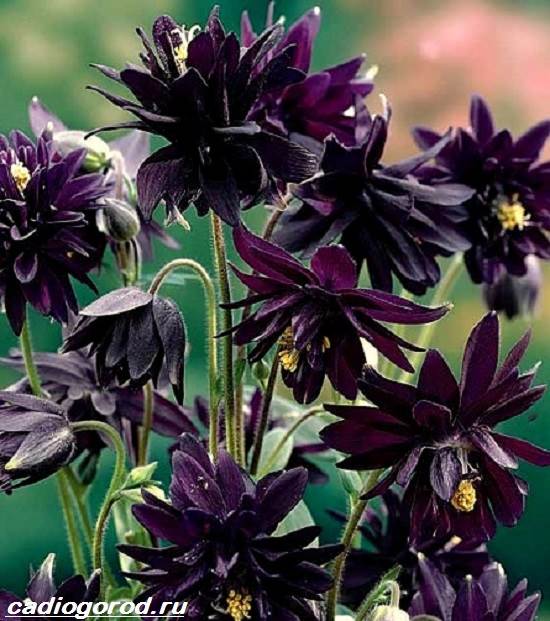

Pictured aquilegia Nora Barlow
A couple hundred is a small price to pay for peace in the house. Irony, of course, But, according to a French legend, one priest advised the catchment to a grumpy woman, from whom her husband was trying to leave. The man could not stand the constant grumbling of his wife.
The priest told the sufferer to make an infusion of Aquilegia and keep it in her mouth every time she wants to drink her husband. Since then, peace has come to the family. You can try with any plant. At least take water in your mouth. But, it was Aquilegia that got into the legend.
Aquilegia in landscape design
The use of aquilegia in landscape design is very wide:
- undersized varieties are perfect for decorating alpine hills;
- low specimens as border plants will perfectly decorate the edge of the flower bed, the cultivation of such varieties is suitable for decorating garden paths;
- medium-sized aquilegia will become a bright accent in mixed plantings, on multi-level mixborders.
A beautiful contrast in landscape design is obtained when arranging perennial plantings along the edge of the site, sown with lawn grass. This feature of the flower to grow into a lush neat bush is also used in combination with ground cover plants.
Those who are intimidated by the painstaking work of caring for a flower bed should not be afraid of aquilegia. It is very easy to propagate a flower, and it will grow practically without participation from the summer resident.
Aquilegia flower in myths and legends
As mentioned at the beginning of the article, this plant of wondrous beauty has several names, sometimes even strange ones. However, there is nothing surprising, because each of them has its own separate story, sometimes even imbued with a sense of humor. For example, the inhabitants of America have long considered this flower a symbol of female infidelity, so bouquets with its presence were considered offensive to the beautiful half of humanity. A similar opinion existed in the distant times of the "Middle Ages" - young women were not given it, but presented only to ladies of free morals. The plant is called "eagles" because of the presence of long flower horns or spurs, in appearance, resembling the claws of an eagle, and also because of the root of the word -Aquila- which in Italian sounds like an eagle.


Aquilegia or catchment, or eagles, or dove, or "elf's shoes"
The British, for example, often referred to this flower as "the meeting house" because a multitude of spurs is similar to a gathering of people. And they also believed that aquilegia in the spring gives additional strength, therefore they called it "the grass of the lion" or "tea of the lion." And since the spurs of the plant look like a jester's cap with bells, for many peoples aquilegia was represented as a symbol of stupidity, respectively, the flowers of this plant represented the beloved Harlequin. Hence, the superstition arose that a presented bouquet will definitely lead to bad luck, and if you give flowers to a man or a woman, then this is an indicator of a stupid act.
Aquilegia Yellow
Another perennial hybrid of the plant is the Aquilegia Yellow variety. Its distinctive feature is the golden flowers of a uniform color, which have a fairly standard shape inherent in the wild-growing catchment. This species is popular in North America, but, recently, it is becoming more and more in demand among domestic gardeners. This is due to the fact that bright flowers of a rich yellow hue begin to bloom early enough and continue to throw out peduncles abundantly throughout the summer.
As for the growing regions, it feels best in regions with a temperate continental climate.
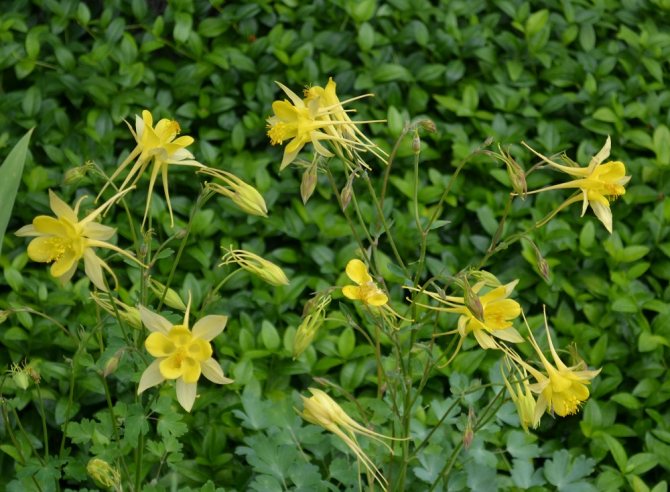

Aquilegia Yellow
Where is the best place to plant aquilegia
Aquilegia prefers a shaded area, but this does not mean that it will not be able to grow in a well-lit area. A plant growing in a sunny location will not look as chic and its flowers will be much smaller.


The drainage basin is unpretentious to the ground. He prefers light, loose soil of moderate moisture. It is advisable to fertilize it with humus or compost.
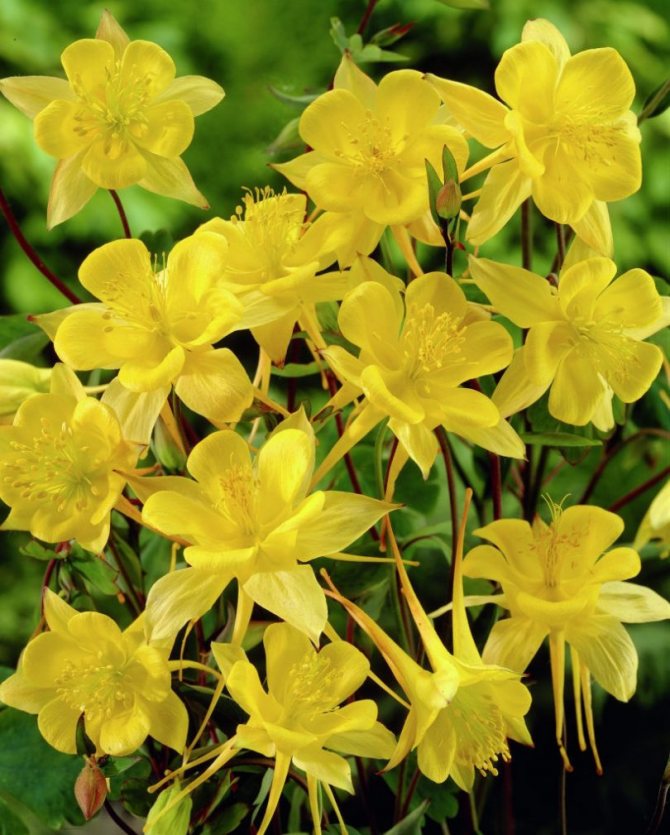

Responsible for the mystery "elven caps"
It is not by chance that Aquilegia have received so many different “fabulous” nicknames. In Europe, they are known as elf caps, in our country - as a catchment, in the North - as forest fairies, and in Latin America they are called forest spirits. Aquilegia conquers not at first sight, but forever.
This is not just one of the main crops for landscaping semi-shady and shady corners, where a mysterious twilight reigns and everything seems to freeze in anticipation of some miracle.Aquilegia in comfortable lighting acts as a kind of "fairy-tale character" - it makes you look closely at the details, look for unexpected associations and attracts attention with movement and mysterious flickering.
Aquilegia so cleverly complement landscape and regular compositions in secluded lighting that sometimes their ability to become an organic part of the relief seems really fabulous. They, fully revealing their mystery in secluded lighting, transform the space with luxurious thickets and at the same time unite the plants growing here, fill the most boring corners with light, details and an inimitable play of textures, nuances and effects.
Aquilegia can be used to create watercolors from a chaotic mixture of wild plants - from lupines to lilies of the valley - or add wild, unbridled magic to compositions with more structured soloists such as hosta and heuchera.
Despite the fact that the "magical" talents of aquilegia are manifested most powerfully in groups and mixed plantings, aquilegia, which, thanks to self-seeding or at the request of the gardener, makes its way along a convenient site literally one bush at a time also retains the charm of a fairy princess. Moreover, in this way she more shows the grace of silhouettes in general and flower stalks in particular, fully demonstrates the shimmering effect of inflorescences.
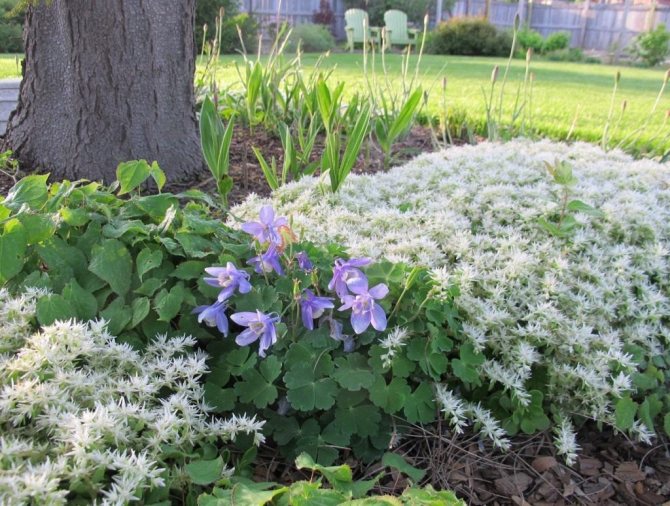

Alpine Aquilegia against the background of sedums. <>
Pests and problems
Leaf miners are the biggest problem. They dig tunnels inside the leaves and can quickly make an unpleasant mess. Cutting the plants after flowering usually clears up the problem. Since Aquilegia does not usually retell, a haircut is the best way to control insect problems. The leaves will eventually fill up again.
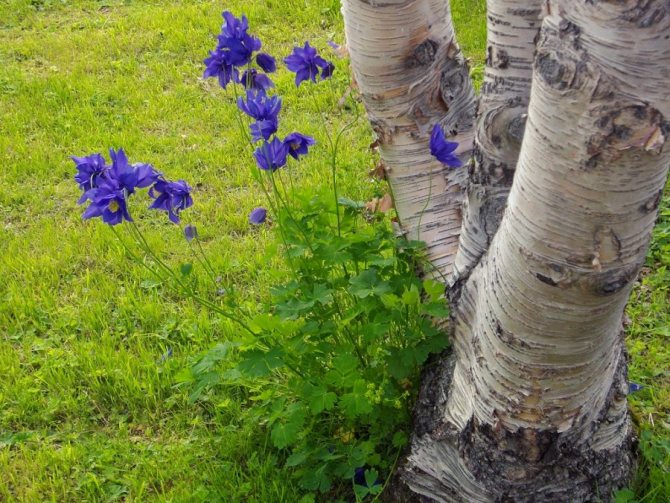

If the leaves of your plant look like someone was drawing a winding line, you have leaf miners. They are the larvae of various beetles, flies, moths and wasps.
An adult lays eggs on a leaf, and the larvae burrow and break through it, feed and leave a transparent trail where they were. If you look closely, you can often see a dark dot at the end of one of the stripes. This is a criminal at work.
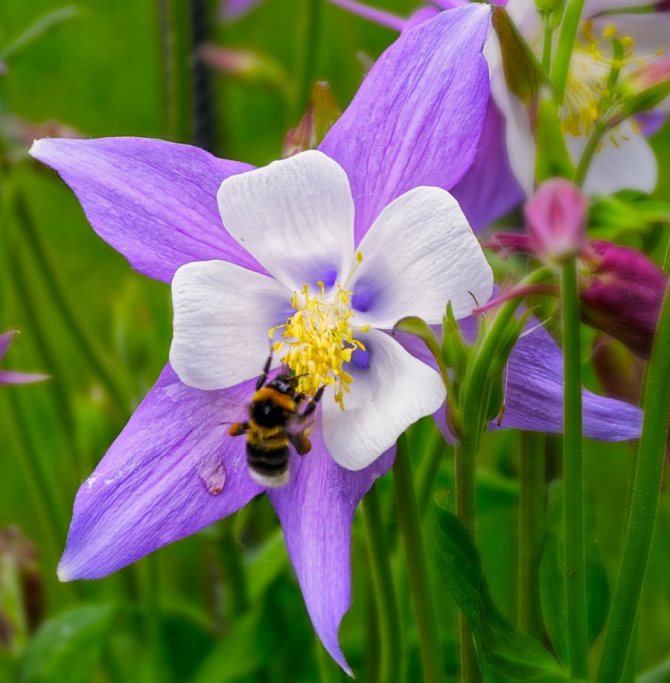

If you see a whitish translucent spot, it could also be a leaf miner. The damage from the spotted miner is often mistaken for some type of disease. The photo here is an okra leaf, but many plants are attacked by leaf miners.
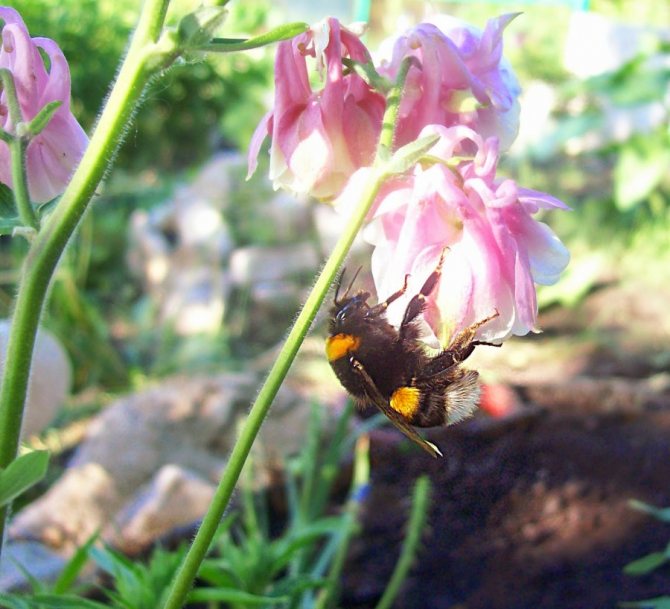

Photo of aquilegia
Features of aquilegia
The development of this plant consists of two stages. At the first stage, a renewal point grows near the stem. In autumn, when the aquilegia fades, a root rosette forms from it. In the spring, the second stage of development begins and then the rosette changes foliage, and a peduncle appears from it, on which flowers with stem leaf plates grow until the end of summer.
The color and size of single flowers are directly determined by the type of aquilegia, of which there are many and colors, respectively, too. Flowers of American and European types of aquilegia are characterized by spur, which is an outgrowth of hollow petals with nectar inside. Aquilegia from China and Japan do not have spurs.
The fruit of the aquilegia is a multileaf, inside which there are poisonous seeds of a dark shade with a germination duration of about 12 months.
The romantic magic of a garden catchment with aquilegia
Both varietal and species aquilegia can play the role of a wonderful partner plant that will fill compositions with touching romantic notes. The delicate beauty of the classic varieties or the daring, sometimes completely unlike aquilegia, the brightness of terry fashionistas are equally well suited for romantic lush compositions.
In ensembles with a focus on flowering and romance, aquilegia, playing the same important role of connecting the ensemble, filling the space with volume and colors of the plant, first of all reveals the beauty of lines and grace of forms. Each flower of this amazing beauty in the company of abundantly flowering plants attracts attention with its unusual structure, drooping shapes and cute touches of "design".
Aquilegia in such compositions is like weaving graceful lace, adding subtle jewelry details to the explosion of colors and pomp. True, the romantic character of aquilegia will fully reveal only on the condition of the selection of contrasting large-colored partners and a very strict choice of harmonious color combinations in the composition with a focus on noble, classic colors - pink, purple, white.
General information
Aquilegia is a herbaceous perennial from the buttercup family. The plant is also known under the names of catchment, eagle, columbina. There are about 120 species, of which 35 are cultivated at home.


The flower has been known to people for a long time
In the Middle Ages, he was depicted in paintings, he meant the presence of the holy spirit. He was mentioned in the literature, for example, Shakespeare in "Hamlet" described how Ophelia gives a Columbine flower to her brother Laertes.
The height of the above-ground part of the aquilegia reaches 1 m. The root has a rod-like shape and many branches. It can grow up to 50 cm deep.
At the base of the shoot, a renewal bud is formed every year. A socket is formed from it. From which leaves and flower stalks emerge.
Leaves that come out of the outlet, triple-dissected, grow on long roots. Stem leaves sit tightly, they have no petioles.
Flowers near the catchment are single. There can be up to 12 of them on one peduncle. The inflorescence is a panicle. She is quite rare, drooping. The diameter of the flower reaches 10 cm, but this, like the color, depends on the variety.
Many species of the catchment area have spurs at the flower, in which nectar accumulates.
There is a classification of the plant according to them:
- Without spur
- With straight spurs
- With curved spurs
The flowering period lasts about a month. It falls in May or June. But there are varieties that bloom until frost.
After flowering, the fruit ripens - a multileaf. Small black seeds ripen in it. Their germination capacity is maintained throughout the year. Self-seeding of seeds is possible.
You need to be extremely careful with aquilegia semes! They contain poison. If accidentally ingested, they will cause severe poisoning.
back to menu ↑
See also: Bobovnik - "golden rain" in your garden: planting in the open field, care, possible diseases, use in landscape design (55 Photos & Videos) + Reviews
Aquilegia after flowering
When the aquilegia fades, the stems that have lost their decorative effect are cut to the very rosette of leaves. Parts of healthy plants can be used for compost, while diseased plants need to be burned to avoid contamination of soil and other plants. If you want to try the seed method of propagation, leave the peduncles with flowers of the varieties you need for the ripening of the seeds, putting on the fruit, in order to avoid self-seeding, gauze bags. After flowering, you can start dividing the bush and at the same time planting the plants. At the same time, in September-October, seeds are sown before winter.
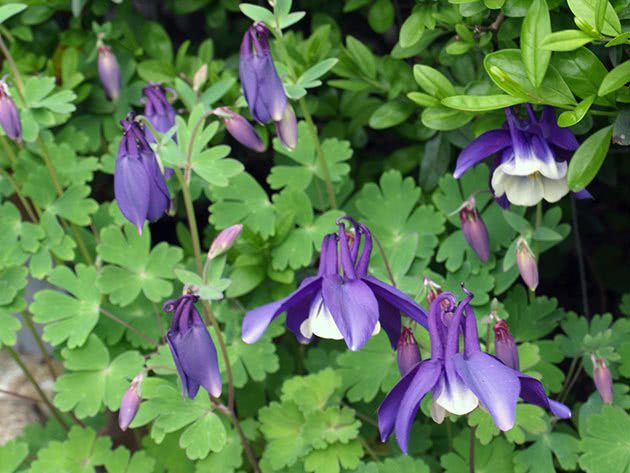

Pictured: Grown from aquilegia seeds
What kind of care does the plant need?
The main concern is relentless loosening of the soil and weeding, timely watering (but not excessive, since the plant is not selective for moisture). It will not be superfluous to feed it 2 times during the warm season. It is possible to add organic or complete mineral additives to the ground.
In order not to decrease decorativeness, it is recommended to transplant the plant to another place every 5 years. Also, after flowering, a mandatory cut of all peduncles is required. And it is better to propagate aquilegia from seeds in such a situation away from the main plants.
Topic: Frost-resistant plant varieties
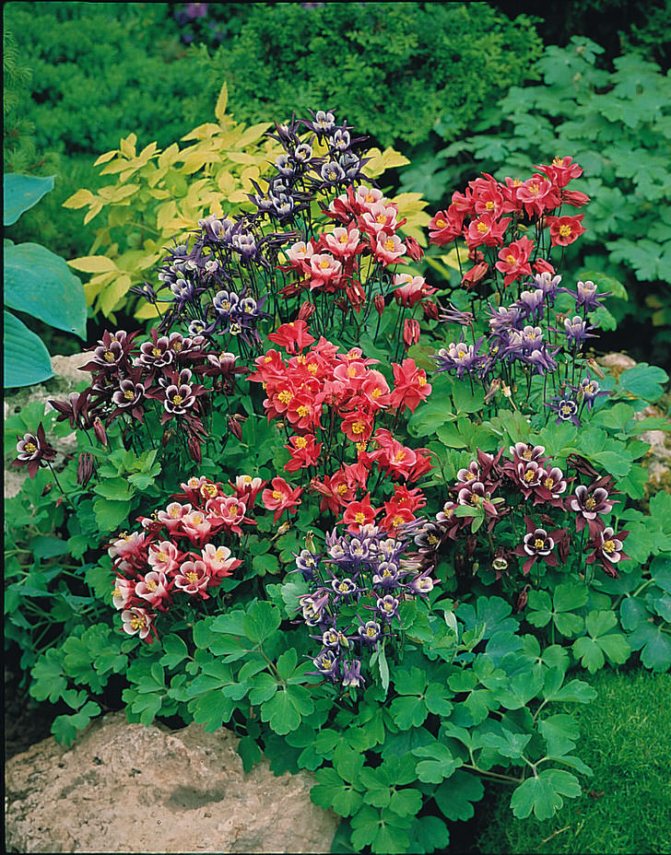

Contrasting inflorescences are the first choice of modern summer residents.
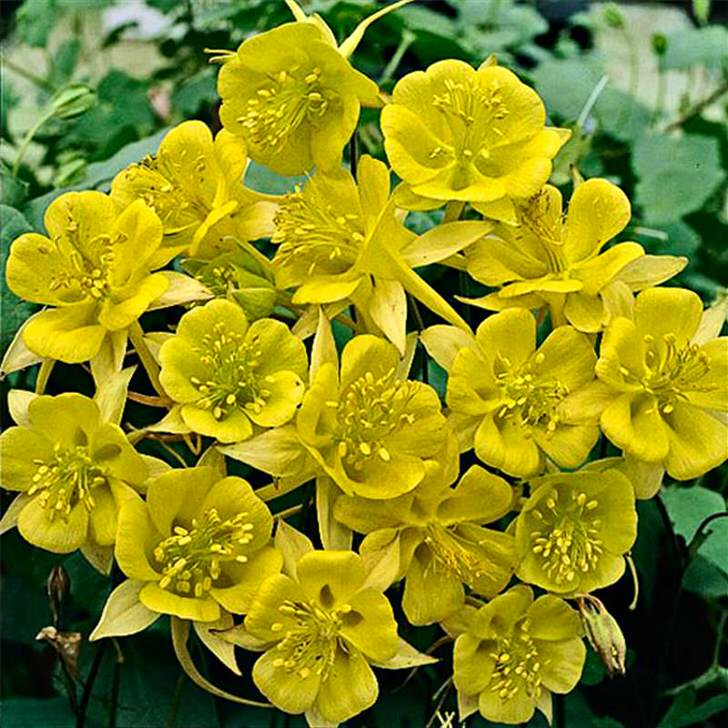

Solar aquilegia in the garden.
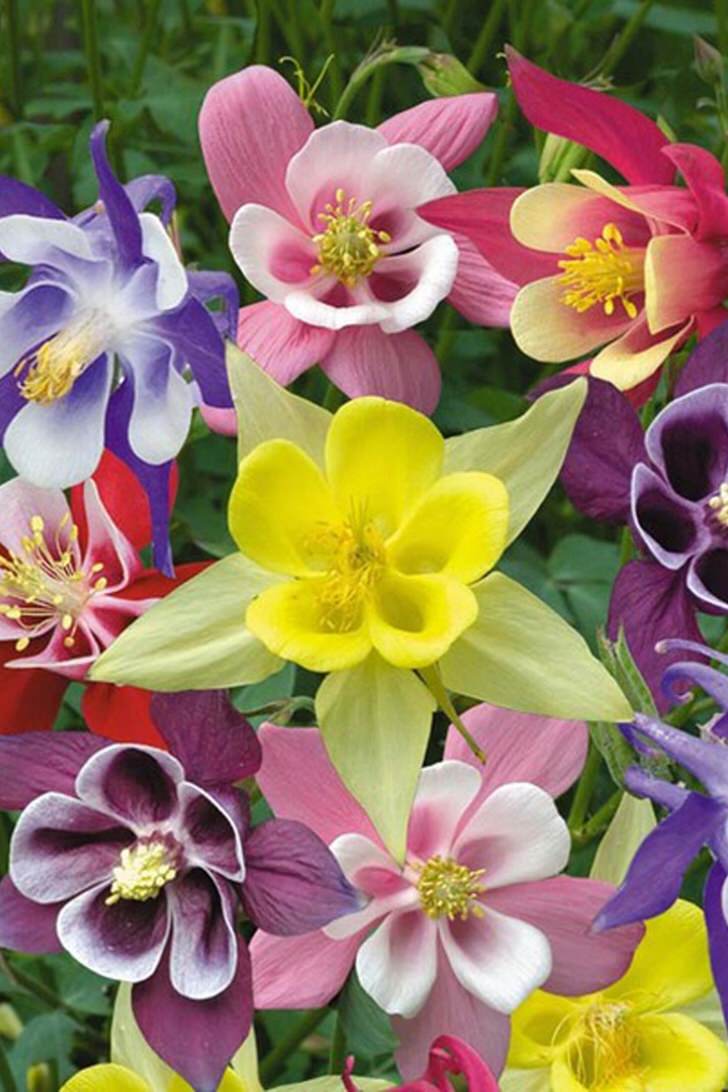

Properly groomed aquilegia flowers.
If the intention is for the aquilegia to bloom early, the cultivation should include forcing the plant. To do this, the rhizome is transplanted in the fall into pots or boxes. They are placed in a dark place, where they are stored until the arrival of constant frosts. For wintering, the pots are transferred to a cold room (in a cellar, for example). Here, aquilegia is left until January-February, and after that it is moved to a heated and maximally bright room. Here it will begin to grow and form flower stems, the room temperature should be about +12 .. + 16 ° С. If all conditions are met, the eagle begins to bloom in early April.
Fertilize the plant first on the site with mineral fertilizers alone: 55-65 g of superphosphate, 25-30 g of saltpeter and 15-25 g of potassium salt. In summer, top dressing usually consists of an aqueous solution of mullein, plus 25 g of superphosphate, 8-13 g of potassium salt. Dosage: per 1 m² - a bucket of nutrient liquid.
Diseases and treatment of aquilegia
This catchment, regardless of the species, tends to get sick. If it is sick with gray rot, then the first step is to cut off the infected elements of the plant. If the plant is infected with rust, we do the same. You can also treat the flower with a sulfur-containing product or a mixture of soapy water and copper sulfate. If your aquilegia is faced with powdery mildew, characterized by a white bloom - treat the bush with a solution of the preparation "Skor" following the instructions.
In addition to diseases, aquilegia often suffers from increased attention from insects: ticks, aphids, scoops and nematodes. To get rid of the first three, you can use a remedy called Actellic or Karbofos. From the latter, alas, there is no effective remedy, so it is easier to dig up an infected bush and instead plant plants resistant to these insects - onions or garlic.
Pest infestation
The dense arrangement of the leaf rosettes impedes the movement of air. In thickets, there is a high probability of infection with gray mold, powdery mildew, rust. For preventive purposes, you need to keep a distance when planting and do not flood the bushes. Sick bushes are destroyed, and the land is treated with sulfur or fungicides.
On hot days, aphids, scoops, spider mites appear on the green mass. They get rid of pests with insecticides such as "Aktara" and "Karbofos".
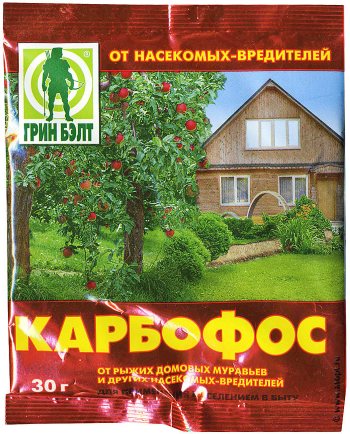

Karbofos
How does the landing take place?
In order for aquilegia to please with its flowering, you need to choose the right planting site and select the soil. She adjoins well with shrubs and loves a sparse shade. Do not place the plant in shady areas, this will affect the color and size of the flowers.
Important! Aquilegia takes root well both on nutritious, loose soil and on poor soil. The plant does not like water to stagnate near the roots, so good drainage is needed.
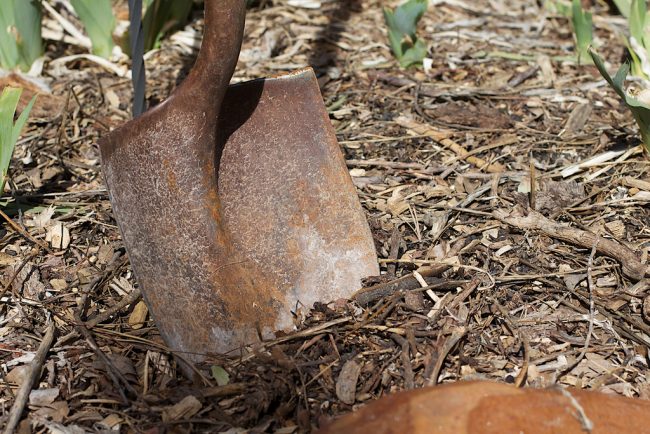

For planting, it is better to use special land purchased in advance.
Advice! When planting, the size of the plants should be taken into account, so they are planted at a distance of 40 cm from each other.
Aquilegia Winky
It is most often used to decorate a garden in landscape design, for interiors (as balcony flowers) or as a potted flower.
A distinctive feature of the Vinky aquilegia is a fairly compact bush, reaching a height of no more than 20-30 cm.
At the end of the stem, 20 cm long, there is one flower, which is most often a double combination of petals, complemented by spurs. Coloring varies from monochromatic petal options to a combination of several shades.
Such an aquilegia at the dacha allows you to effectively decorate not only the flower beds, but also the facade of the building, since the designers suggest planting it in hanging pots.
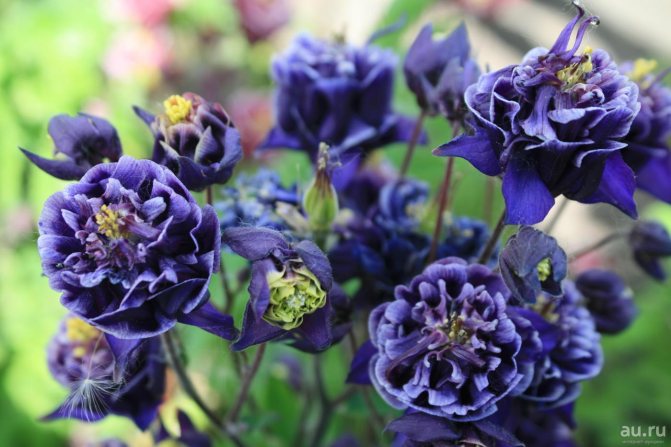

Aquilegia Winky
Aquilegia in winter
There is another type of work that needs to be done after the aquilegia blooms. The fact is that in four to five-year-old plants, roots begin to protrude from the ground, from which young leaves and shoots suffer, therefore, after removing the peduncle, pour peat-manure compost with humus under the bush to cover these roots. Thus, aquilegia will receive top dressing before winter and at the same time will be protected from frost by mulch.
Plant a lupine in the garden - a beautiful flower and siderat
Features and description of aquilegia
Aquilegia is a perennial herb and belongs to the buttercup family. The aquilegia flower has been known since the Middle Ages, when it was a regular guest on all household plots. This flower is mentioned in works of art: paintings and novels. It used to be used to ward off evil spirits.
North America is considered its homeland, and in nature it can grow in the northern part of Europe. Therefore, our climatic conditions are quite pleasant for him. This flower has a very interesting feature - a large number of names. In addition to its Latin, which in translation means "collecting water", it is called Columbine in England and America, "five birds together" in Austria, "elf's shoe" in Germany, eagle or catchment in Russia.
Fresh articles about garden and vegetable garden
Pepper seedlings do not grow, stands still, what to do?
If the seedlings of cucumbers are very elongated, what to do?
Planting peas in spring sowing: when to sow, how to plant correctly?
Aquilegia Columbina
This is a perennial with a compact, but rather tall bush - up to about 70 cm. The variety is cold-resistant, which makes it, like Aquilegia Usual, suitable species for growing in Siberian regions.
A distinctive feature of the Columbine aquilegia is a more elongated flower shape, reminiscent of a bell-shaped bowl. Petals can range from the lightest (whites) to deep deep purples.


Aquilegia Columbina
Autumn care and wintering of plants, collection of seeds
After the end of flowering, aquilegia loses its attractiveness. Therefore, it is recommended to cut dry, sluggish stems to the very leaf outlet. At this time, seeds are collected for future sowing. For seed ripening it is better to leave the lower peduncles. To prevent the seeds from spilling out on the ground, it is recommended to put gauze bags on the seed pods. The collected seeds are dried indoors. If they are not sown immediately after harvest, they can be stored for no more than 5 years, preferably at low temperatures.
After flowering, the aquilegia enters a resting phase. She needs to ensure proper wintering. The bush is examined and pruned to a root outlet. If a transplant is planned, the bush is divided. If not, sprinkle it with mulch (peat and humus) and leave it to rest until spring. Thus, Aquilegia will receive top dressing and will be protected from the winter cold.
Basic description
The plant has a two-year life cycle - during the first year, a point for renewal is formed, located near the base of its shoot, after the autumn stage of flowering, a root rosette will grow from it. But already with the first days of spring, these leaves will die off.
The time comes for new leaves to appear, creating a new version of the rosette, and a full-fledged peduncle will form in its center, which is necessary to accommodate the leaves of the stem and flowers.
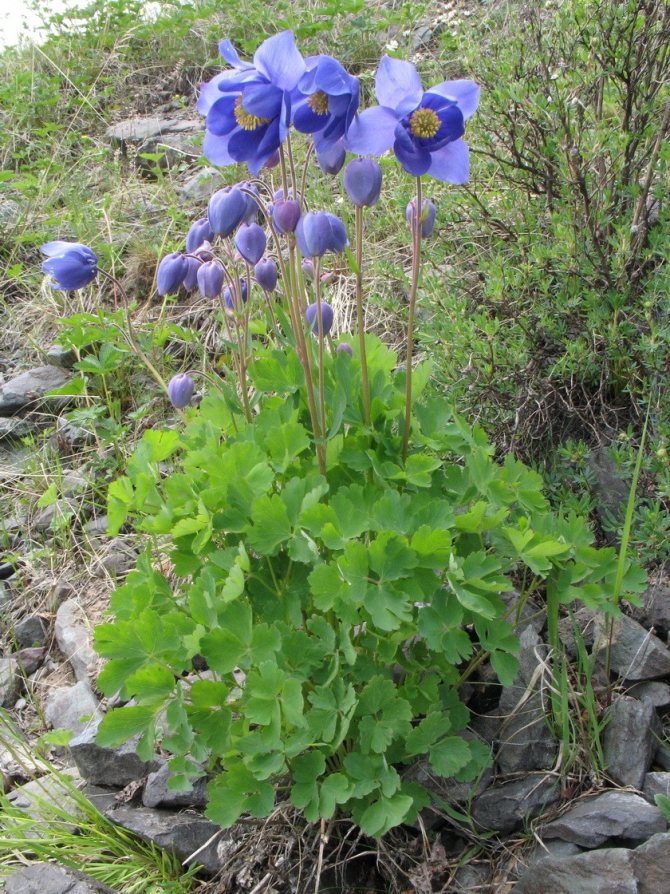

The leaves that create the rosette are distinguished by elongated petioles, they can have two or three cuts on the basis of the triple type, while the stems have a sedentary structure of the triple type.
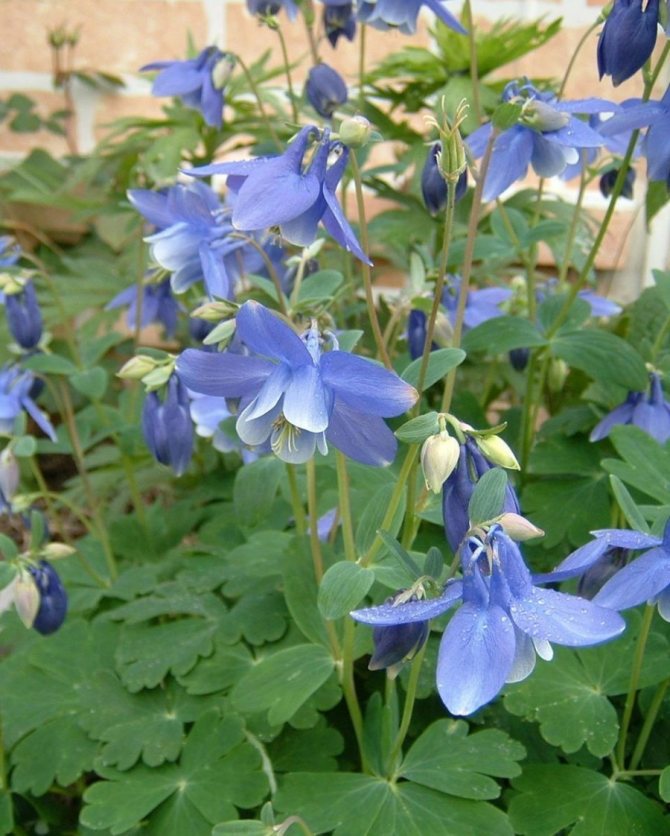

The flowers are distinguished by a single version of the design and they are directed towards the ground, and also differ in different species, varieties: in size, color - blue, white, crimson, yellow, two-color based on several shades. You can appreciate their beauty from a photo of aquilegia in all its diversity.
Some species have spurs based on hollow-type processes in the form of cups or full-fledged petals filled with flower nectar.


Many species growing on the territory of America or Europe have spur characteristics. And the various species found in China or Japan do not have spurs in the flower structure.
The fruit is formed in a multi-leaved manner on the basis of small shiny and at the same time black seeds that have poisonous properties and retain the possibility of seedling formation throughout the year.


Medicinal properties
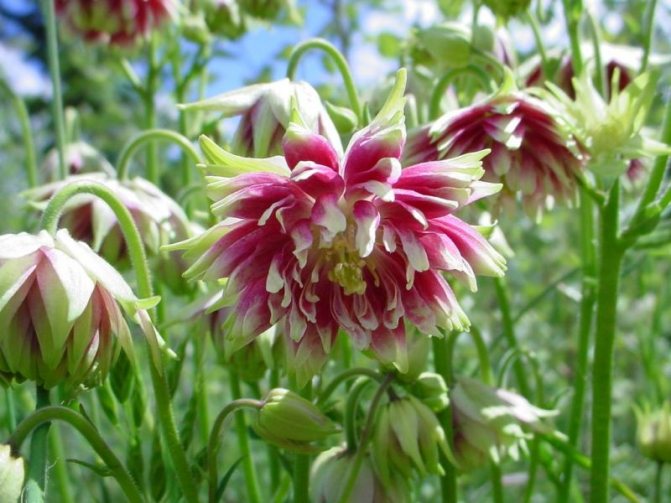

Aquilegia ordinary Nora Barlow
Traditional medicine does not use aquilegia in pharmacology. Narodnaya, on the contrary, widely uses it.
It is believed to treat diseases such as:
- Hepatitis
- Impotence
- Pneumonia
- Stomach colic
- Mastopathy
- Menstrual pain
- Cough
- Skin diseases
- Dropsy
Decoctions are made from the plant... Which are used in the form of drinks, lotions, compresses. Raw materials are harvested during the flowering of the plant. Then it is dried. Store in fabric bags.
It is strictly forbidden to use traditional medicine, from poisonous plants for pregnant women, nursing mothers. Children under 14 years old.
back to menu ↑
See also: Garden gerbera: description, species and varieties, planting and caring for an African flower in the open field, reproduction, possible diseases (40+ Photos & Videos)
Aquilegia - a poisonous flower
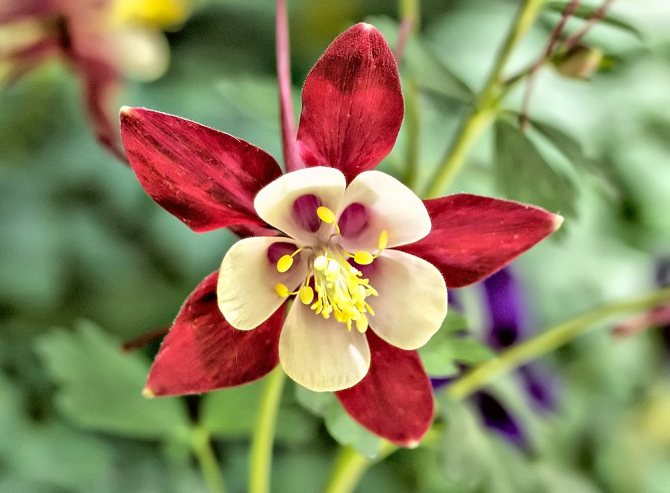

Flowering catchment
The terrestrial part of the aquilegia contains poison. Cases of poisoning are not uncommon. Children pick beautiful flowers, then put their hands in their mouths. Adults, unknowingly, decorate her dishes.
Many, having found a recipe for traditional medicine with its content, are trying to get rid of diseases. Without knowing the dosages, this cannot be done. Use is possible only under the supervision of a specialist.
In medieval society, it was believed that aquilegia flowers protect from witchcraft and various damages. It was given to loved ones to protect them from misfortunes.
Signs of aquilegia poisoning:
- Weakness
- Nausea
- Vomiting
- Dizziness
- Drowsiness
- Convulsions
- Tingling of the tongue
- Darkening in the eyes
- Poisoned people cease to distinguish colors
- Heart rate failure
In case of poisoning, measures must be taken immediately:
- Call an ambulance
- Drink activated charcoal
- You can give the poisoned person a raw chicken egg, milk, or a piece of butter to drink. These foods envelop the walls of the stomach and minimize the absorption of toxins.
- A poisoned person must be placed on a heating pad
- Ambulance doctors must be sure to tell what caused the poisoning
Popular types
The genus of aquilegia has 102 registered species. 35 are grown in culture. Of these, the following are widespread:
- Ordinary 30-70 cm high. Petiolate, trifoliate leaves are collected at the base of the bush and occasionally grow along the stem. Flowers of pink, blue, purple color open in early summer. Frost resistant.


Ordinary - Aquilegia terry, as in the colorful photo of flowers, obtained as a result of selection. Attractive with beautiful and lush inflorescences. Arrows up to 1 m high bear single erect or drooping rims. Large flowers with a diameter of about 10 cm are created by several rows of narrow petals. The color of the petals is different at the edge and near the base.


Terry - Siberian, known in folk medicine as a tonic and choleretic agent. A straight, almost leafless stem rises 30-70 cm above the ground. The base is covered with thick, dark green leaves. Flowers 5-10 cm in size are painted in blue or lilac-purple. Massive spurs 2 cm long along the contour of the petals. Flowering time: from May to September.
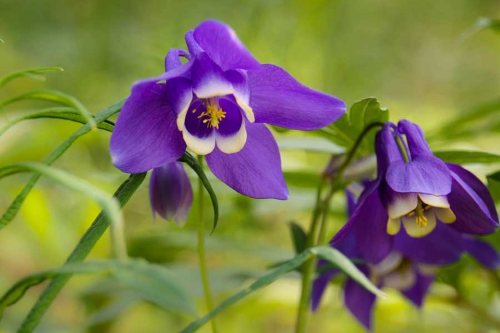

Siberian - Hybrid includes a large number of hybrids from 50 to 100 cm in height. Plants have large flowers with spurs and expressive, juicy color.
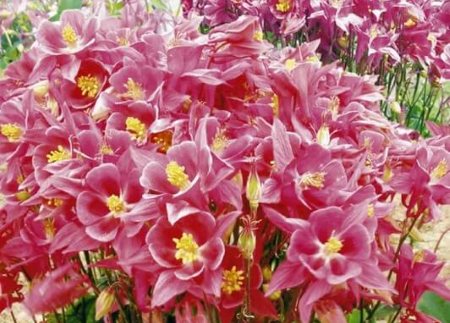

Hybrid pink
Among them:
- "Star" with blue, red, blue, pink and white huge flowers, decorated with a light center. Flower height 60-80 cm.
- "Tower" with double rose flowers.
- "Winky" is a small bush with dense inflorescences on high peduncles.
- "Cameo" is a dwarf species with a height of only 10-15 cm. Differs in early blooming of multi-colored buds.
- Biedermeier is a pot culture. Double flowers with a diameter of 4-5 cm bloom above the bushes 25-30 cm high.
Aquilegia Terry
Aquilegia Terry is an unusual plant variety, which is distinguished by the largest flowers, reaching a diameter of 10 cm. It was artificially bred in order to diversify flowers and achieve a certain effect.
A distinctive feature is the multi-petal structure. The flower itself is formed from narrow petals arranged in several rows. In terms of coloration, the intensity of the color decreases as it approaches the center. Shades can range from white to lilac.
There is a specific bluish bloom on the leaves of this plant.
Note! When breeding Aquilegia Makhrova, breeders managed to achieve higher frost resistance. This makes it possible to grow a plant of this variety in more northern regions than its natural distribution area.
This is what ensured the great popularity of the variety among gardeners.


Aquilegia Terry
Wintering
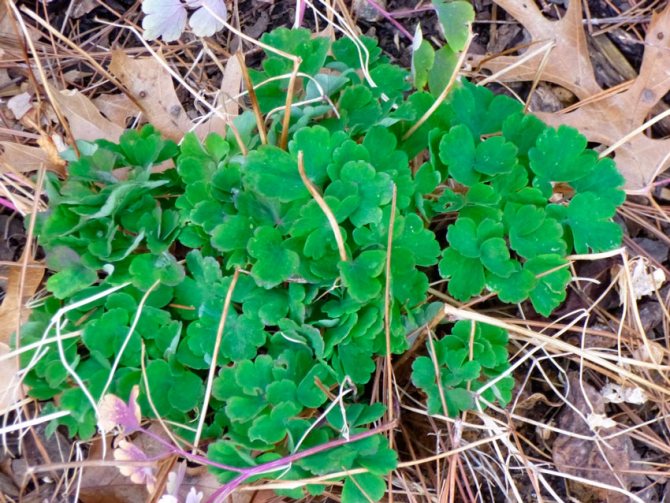

In autumn, special attention should be paid to bushes that are 4–5 years old. The fact is that their roots begin to bulge out of the soil, and this is very harmful to young leaves and shoots. In this regard, when the peduncle is removed, the surface of the soil under the bush should be sprinkled with humus mixed with peat-manure compost, this will cover the roots. In this case, the flower will be fed and protected from the autumn and winter cold.

